News
Scientists Find the Universe’s Missing Matter? The Energy that Bridges Galaxies

Recently, a few studies were released that claim to identify the missing matter in the Universe.
They say the missing matter in their calculations may come from a kind of energy that connects galaxies: filaments of hot gas that link galaxies together.
Scientists from the nearly 500 year old institution the University of Edinburgh in Scotland, and researchers from the Institute of Space Astrophysics (IAS) in Orsay, France performed them.
It has long been said that calculations about the mass of the universe do not add up. “Dark matter” is a theoretical concept used to explain this anomaly in calculations.
According to Futurism:
“The two teams confirmed that the missing ordinary matter in the universe can be found in the form of filaments of hot, diffuse gas linking galaxies together.
While long predicted, these gasses have a tenuous nature that has made them impossible to detect using X-ray telescopes. To get around that, both teams made use of the Sunyaev-Zel’dovich effect. This phenomenon occurs when leftover light from the Big Bang passes through hot gas, leaving behind a trace of the gas that can be captured. A map of this effect within the observable universe was produced by the Planck satellite in 2015.”
While it’s not easy to reason through this as an ordinary person, and see how exactly scientists calculated the mass of the observable universe and decided some other type of matter was missing from the equation, we can at least try to put these theories to the test.
The first study is titled “Missing baryons in the cosmic web revealed by the Sunyaev-Zel’dovich effect.”
Reading from the summary of the paper:
“Observations of galaxies and galaxy clusters in the local universe can account for only 10% of the baryon content inferred from measurements of the cosmic microwave background and from nuclear reactions in the early Universe. Locating the remaining 90% of baryons has been one of the major challenges in modern cosmology. Cosmological simulations predict that the ‘missing baryons’ are spread throughout filamentary structures in the cosmic web, forming a low density gas with temperatures of 105−107 K.”
As one can see, it gets a little complicated. It would require further research to internalize what “baryon content measured in the cosmic microwave background” exactly means.
It essentially claims that simulations predict the missing baryons are actually present in a “cosmic web,” a “filamentary structure” that connects galaxies. The idea is certainly fantastic and satisfying to our innate curiosity.
Now to reason through how accurate that simulation they cite is, it’s pretty much a dead end for critical thought. I can’t think of a way to verify that their simulation is accurate or inaccurate.
The second study, titled “A Search for Warm/Hot Gas Filaments Between Pairs of SDSS Luminous Red Galaxies” references Planck satellite data in searching for those filaments that may bridge galaxies, apparently referring to a massive amount of data released in 2015 by the Planck satellite.
A summary of it reads:
“We search the Planck data for a thermal Sunyaev-Zel’dovich (tSZ) signal due to gas filaments between pairs of Luminous Red Galaxies (LRG’s) taken from the Sloan Digital Sky Survey Data Release 12 (SDSS/DR12). We identify ∼260,000 LRG pairs in the DR12 catalog that lie within 6-10 h−1Mpc of each other in tangential direction and within 6 h−1Mpc in radial direction. We stack pairs by rotating and scaling the angular positions of each LRG so they lie on a common reference frame, then we subtract a circularly symmetric halo from each member of the pair to search for a residual signal between the pair members. “
The Planck satellite data was explained in a February 5th, 2015 release from Columbia University:
“Long awaited data from the Planck satellite was released today, papers available here. The accompanying press release leads with results about the timing of the first stars, 500 million years or so after the big bang, with little mention of the very early universe.”
The purpose of this article is to critically think through the info in these studies, and try to reason through what these scientists are saying instead of taking it as fact immediately.
It is difficult to reason through things past a certain level of complexity when we are presented with any scientific study. In this one, at a certain point it does get complicated to the point of difficulty.
One observation that can be made is that the nature of these studies is very centralized. They are centralized in this Planck satellite data, or a simulation that we can’t quite verify the accuracy of ourselves.
Planck is probably a reference to the old Max Planck institutions in Germany, a range of universities and institutions formerly given the name “Kaiser Wilhelm.”
In Germany, the Max Planck institutions centralize science just as in the United States, the academic institutions such as Harvard, Stanford, the University of Chicago, ect. make their scientific direction, method, and every aspect of what they do very centralized.
At the same time, the institutions help government agencies like DARPA and produce technology and things for the state. The powerful universities are “with the sh*t” so to speak: they side with the state and other powers that aren’t out for the best interest of the people. However, these particular studies are fascinating.
Within the massive umbrella of these universities, of course some innocuous, fantastic, or brilliant findings come about. For the sake of having a full perspective and not being naive, it is necessary to know all of this.
So when info and scientific direction is so centralized in specific institutions, that cooperate and work with government and corporations, we really should be reasoning through what they say critically. We should be taking the time to reason through things like this regardless.
These certainly are some entertaining theories and it can be satisfying to think about such things. Hopefully people will derive satisfaction from also challenging themselves to critically reason through everything.
After all, “science” does not mean the authority of people in academic institutions who call themselves scientists: true science is a non-corruptible idea. Science is the method of proving something with tangible evidence, it has nothing necessarily to do with “scientists.”
(Image credit: Deviant Art)
News
UK Meteorite That Fell To Earth Contains Building Blocks For Life
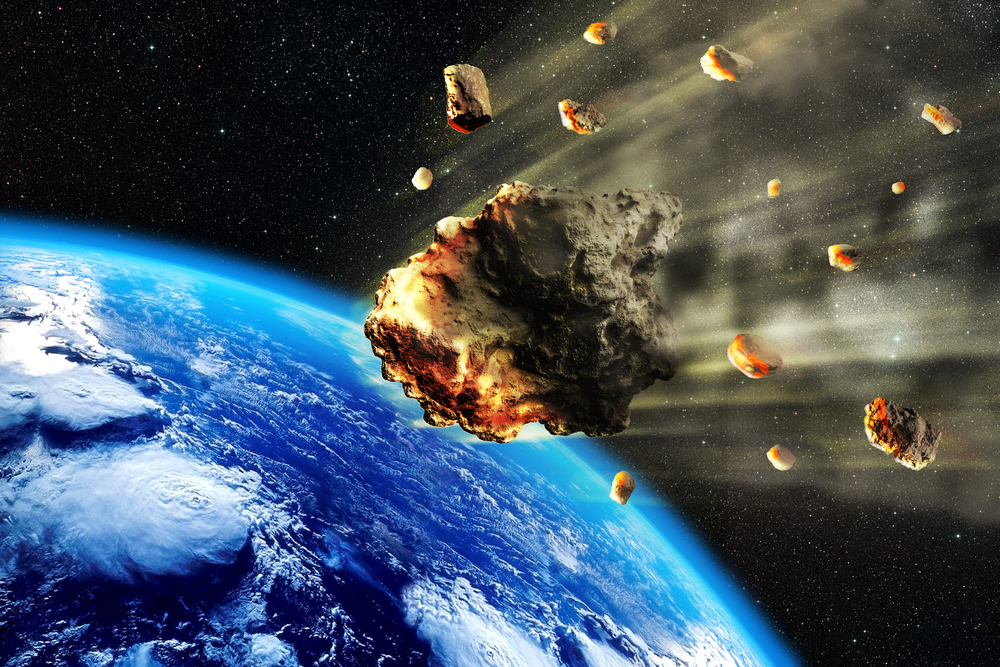
In the quiet expanse of the night sky over Gloucestershire in early 2021, a brilliant streak of light announced the arrival of something extraordinary—a rare visitor from the depths of space. This was no ordinary meteorite; it was a bearer of mysteries locked within its ancient, rocky core. Dubbed the Winchcombe meteorite, this celestial object is now at the forefront of a groundbreaking scientific revelation that might just hold the keys to understanding the origins of life itself. What secrets do these cosmic fragments hold about the building blocks of life as we know it?
Discovery and Initial Analysis of the Winchcombe Meteorite
The Winchcombe meteorite, which graced the skies over Gloucestershire, UK in 2021, has proven to be a remarkable source of scientific data, particularly regarding the origins of life. This meteorite is classified as a carbonaceous chondrite, a rare type of meteorite known for containing high levels of organic compounds.
Upon its rapid recovery—within just 12 hours of landing—the pristine condition of the Winchcombe meteorite allowed scientists to prevent most terrestrial contamination and preserve its authentic cosmic composition. This quick retrieval was crucial, as the integrity of nitrogen-bearing compounds within the meteorite are highly susceptible to alteration by Earth’s environment.
The advanced analysis conducted using electron microscopy at the SuperSTEM laboratory revealed the presence of amino acids and polycyclic aromatic hydrocarbons (PAHs), fundamental organic compounds considered as building blocks of life. This method proved particularly beneficial as it avoids the use of chemicals that could alter the sample, providing a clearer picture of the meteorite’s original state.
Dr. Queenie Chan’s team at Royal Holloway highlighted the importance of these findings. The organic compounds discovered, particularly amino acids, are key to understanding early life’s chemical beginnings. These discoveries offer a glimpse into the solar system’s history and suggest that such meteorites might have contributed to seeding early life on Earth by delivering these essential organic materials.
Scientific Significance of the Winchcombe Meteorite Discovery

The discovery of the Winchcombe meteorite has profound implications for the field of astrobiology and our understanding of the solar system’s history. This meteorite, a carbonaceous chondrite, has provided valuable insights due to its rich content of organic compounds, including amino acids, which are essential for life. These discoveries are significant because they support the hypothesis that the building blocks of life on Earth may have been delivered from space via meteorites like Winchcombe.
Amino acids are critical components of proteins, which are necessary for life as we know it. The presence of these organic compounds in the Winchcombe meteorite suggests that similar space rocks could have contributed to the prebiotic chemistry that led to life on Earth. This notion is bolstered by the pristine condition of the meteorite, which avoided terrestrial contamination due to its rapid recovery post-fall. The specific conditions and chemical environment of the Winchcombe meteorite’s parent asteroid might have facilitated the synthesis of these amino acids, making it a valuable sample for studying the potential for life’s origins in similar extraterrestrial environments.
The findings from the Winchcombe meteorite not only enhance our understanding of the chemical processes that may occur on asteroids but also help trace the solar system’s evolutionary history. The ability to analyze these compounds without the interference of chemical treatments marks a significant advancement in meteoritic research. This methodological innovation is crucial for accurately studying the complex organic chemistry of celestial bodies and could influence future analyses of samples returned from space missions, such as those from asteroids by Hayabusa2 and OSIRIS-REx.
The research on the Winchcombe meteorite extends beyond academic interest. It provides a clearer picture of how organic compounds are distributed in the cosmos and their role in the emergence of life, potentially on planets beyond Earth. These insights not only deepen our understanding of life’s potential ubiquity in the universe but also underscore the importance of future missions aimed at collecting and analyzing extraterrestrial samples.
Comparison with Other Meteorites
The Winchcombe meteorite offers unique insights when compared with other carbonaceous chondrites, particularly in its composition and the conditions it endured through the solar system’s history. Classified as a CM carbonaceous chondrite, it shares characteristics with other members of this class but also displays unique features that set it apart.
Unique Features of the Winchcombe Meteorite
- Preservation and Pristine Condition: The Winchcombe meteorite is noted for its excellent preservation, which has allowed for a level of analysis almost unprecedented for a meteorite not directly returned from space missions like those involving moon rocks or asteroid samples. This pristine condition is attributed to its rapid recovery, which minimized contamination and preserved its original composition.
- Water and Organic Compounds: The presence of water and organic compounds in Winchcombe is particularly significant. Studies suggest that parts of the meteorite were chemically altered by water from its parent asteroid, which likely facilitated the formation of its amino acids—some of which are rare on Earth. This supports theories that carbonaceous chondrites like Winchcombe could have delivered the ingredients necessary for the emergence of life on Earth.
- Mineral Composition and Alteration: Winchcombe’s composition includes a high proportion of carbonate minerals, suggesting a carbon-rich nature that might have accumulated and later melted from frozen CO2. This finding is important as it provides insights into the meteorite’s thermal history and the chemical processes that occurred on its parent body before it landed on Earth.
Winchcombe’s composition and mineralogy align it with other highly aqueously altered CM chondrites, but it also shows unique aspects in its mineral composition that are not commonly observed. These unique features include variations in its magnetic composition, which provides valuable data about the magnetic conditions during its formation, offering clues about the early solar system’s environmental conditions.
Implications for Astrobiology

The discovery of the Winchcombe meteorite has significant implications for the field of astrobiology, particularly in understanding the origin and distribution of life across the cosmos. The presence of organic compounds such as amino acids and nucleobases within Winchcombe, which are crucial for life, supports the longstanding hypothesis that life’s building blocks were delivered to Earth by meteorites and comets.
Astrobiological Significance
- Organic Compound Formation: The Winchcombe meteorite demonstrates that organic compounds can form in the harsh conditions of space and be preserved in meteorites. This discovery underscores the possibility that life, or at least the conditions necessary for life, could be more widespread in the universe than previously thought. The ability of these organic materials to survive in space bolsters the theory that life might not be unique to Earth but could potentially arise wherever the right conditions exist.
- Water-Bearing Minerals: The co-existence of water-bearing minerals and organic compounds in Winchcombe suggests that meteorites could have delivered not only the chemical precursors to life but also the water necessary for biological processes. This has profound implications for the potential habitability of other planets and moons in our solar system, such as Mars or Europa, which may have environments where similar chemical processes could occur.
- Biosignature Detection in Space Missions: Understanding the formation of life’s building blocks in meteorites like Winchcombe can enhance the methods used by scientists to detect biosignatures on other planets. This knowledge is critical for missions that aim to find signs of past or present life on other celestial bodies. The insights gained from Winchcombe can help refine the techniques for detecting similar compounds in the atmospheres or surfaces of planets and moons.
The findings from the Winchcombe meteorite not only advance our scientific understanding but also prompt deeper philosophical and spiritual reflections on humanity’s place in the universe. The notion that the ingredients for life are scattered throughout the cosmos and might converge to create life under favorable conditions suggests a potentially interconnected universe where life’s emergence is a general rule rather than an exception.
Future Research and Exploration
The Winchcombe meteorite’s discoveries have opened several new avenues for future research and exploration, promising to deepen our understanding of the early solar system and the processes that may have contributed to the origins of life on Earth.
Planned Research Directions
- Advanced Microscopy Techniques: Future studies will leverage advancements in electron microscopy to explore the Winchcombe meteorite’s organic compounds with unprecedented detail and efficiency. This will include using state-of-the-art detectors and imaging techniques that allow scientists to examine these materials at the atomic level without altering them through chemical treatments.
- Isotopic and Chemical Analysis: Researchers plan to continue detailed isotopic and chemical analysis of the Winchcombe meteorite to better understand the conditions under which it formed. This includes studying the water content and the types of organic molecules it contains, which are crucial for unraveling the meteorite’s history and its potential role in delivering life’s building blocks to Earth.
- Comparative Studies with Other Celestial Bodies: The insights gained from Winchcombe will be compared with data from other meteorites and celestial samples, including those returned by missions such as Japan’s Hayabusa2 and NASA’s OSIRIS-REx. This comparative approach is essential for confirming the findings from Winchcombe and understanding their broader implications across different environments in the solar system.
- Simulation and Modeling: To complement physical analyses, simulations and modeling of asteroidal processes observed in Winchcombe will be conducted. These studies will help clarify how water and organic molecules interact in space environments, contributing to our theoretical understanding of how life might arise on other planets.
The research on the Winchcombe meteorite is not only enhancing our knowledge of space rocks but also shaping future space missions. By identifying the types of materials that are most informative for studying the early solar system, scientists can better design missions to target asteroids that are likely to yield valuable data. This will aid in planning sample return missions and in situ analysis, providing a clearer picture of our solar system’s history and the distribution of water and life’s building blocks within it.
Epilogue: From Cosmic Seeds to Earthly Life
The study of the Winchcombe meteorite opens a unique window into the past, offering invaluable insights into the conditions that may have fostered the emergence of life on Earth. Its rare composition and the presence of organic compounds such as amino acids and nucleobases underscore the meteorite’s potential role in seeding life’s building blocks on our planet. As one of the most pristine extraterrestrial samples analyzed to date, Winchcombe not only enriches our understanding of meteoritic science but also acts as a critical piece in the puzzle of the solar system’s history.
The implications of the findings from Winchcombe extend beyond our earthly confines, influencing future missions and the search for life beyond Earth. With advanced technologies and further explorations planned, the lessons learned from this meteorite will guide the next steps in planetary science and astrobiology. As researchers continue to unravel the mysteries locked within these ancient rocks, the story of our solar system, and potentially the story of life itself, will become clearer.
This meteorite’s journey from the asteroid belt to a driveway in Gloucestershire not only captivates the imagination but also serves as a reminder of our universe’s interconnected nature and the cosmic processes that shape our world.
News
Yes, Atheists Do Have A Good Moral Compass, Study Shows

For centuries, morality has been tied to religion, with the faithful often seen as the torchbearers of ethical behavior. Atheists, by contrast, have faced an enduring stigma: the idea that without belief in a higher power, their moral compass is skewed or even nonexistent. This stereotype, though pervasive, is being increasingly questioned by science. Recent research reveals a different story—atheists possess a robust sense of morality, one that often aligns closely with, and in some cases even surpasses, that of their religious counterparts.
This groundbreaking study challenges the long-held assumption that morality requires divine guidance. Instead, it unveils how empathy, fairness, and harm prevention—universal values transcending religious boundaries—guide the ethical decisions of nonbelievers. As societies grow more secular, these findings invite a critical reexamination of what it truly means to be moral in a world where belief systems are as diverse as humanity itself.

The Amoral Atheist Myth: Why It Persists
The notion that atheists lack moral integrity is deeply rooted in history, often stemming from the assumption that ethics are inherently tied to religious belief. For centuries, societies have equated morality with divine commandments, portraying religion as the sole foundation for distinguishing right from wrong. This association has left nonbelievers grappling with misconceptions about their moral frameworks.
One reason this stereotype persists is the influence of cultural narratives and religious institutions that emphasize a moral monopoly. In many parts of the world, especially where religious traditions dominate, atheism is often equated with nihilism or moral relativism. As a result, atheists are frequently viewed with suspicion or even outright distrust—a phenomenon supported by surveys revealing that atheists are among the least trusted groups globally.
However, these perceptions often fail to account for the complexity of human morality. Moral behavior, as research increasingly shows, is not exclusive to religious individuals. Instead, it emerges from universal values and social constructs that transcend faith, offering a strong counterpoint to the myth of the “amoral atheist.“
Morality Without Divine Guidance: What the Study Revealed
A groundbreaking study conducted by an international team of researchers dismantles the long-held belief that morality is exclusive to the religious. The research, which surveyed diverse groups of religious and non-religious individuals, found that atheists exhibit a strong moral compass rooted in universal human values. Key factors like empathy, fairness, and a commitment to reducing harm were central to their ethical decision-making.
One of the most compelling findings was that atheists tend to prioritize tangible outcomes over adherence to rigid moral codes. Their decisions are often guided by a practical evaluation of harm and benefit, rather than a fear of divine punishment. For example, in hypothetical moral dilemmas, atheists showed equal, if not greater, consideration for the welfare of others compared to their religious counterparts.
The study also revealed that while religious participants often based their moral decisions on group cohesion and adherence to doctrine, atheists leaned toward individual reasoning and logic. This divergence underscores how secular morality is not about rejecting ethics but instead reinterpreting them through a lens of human-centered principles.

Why Atheists May Seem Less ‘Moral’ to Others
Despite evidence to the contrary, atheists are often perceived as less moral than their religious peers. This discrepancy stems from a combination of psychological biases and social conditioning, rather than any measurable difference in ethical behavior.
One significant factor is in-group bias—a tendency for people to trust and favor those who share their beliefs. In societies where religion is deeply embedded, atheists are often seen as outsiders, which can lead to mistrust. A 2017 study published in Nature Human Behaviour found that religious individuals were more likely to view atheists as capable of unethical behavior, such as cheating or lying, even without direct evidence.
Cultural narratives also play a role. Many religious teachings link morality with divine guidance, reinforcing the idea that those who reject faith must also reject ethical principles. This perception is further amplified by media portrayals and political rhetoric, which often frame atheism as a rejection of all moral accountability.
Interestingly, this bias persists even in secular societies, suggesting that these misconceptions are deeply ingrained. By exploring the roots of these perceptions, we can begin to dismantle the unfounded association between atheism and immorality, paving the way for a more nuanced understanding of ethics.
How Atheists Define Goodness
For atheists, morality isn’t dictated by sacred texts or divine authority—it is grounded in reason, empathy, and a commitment to the well-being of others. This secular approach to ethics prioritizes the tangible impacts of actions, focusing on harm reduction and fairness over rigid adherence to prescribed codes.
Atheists often draw from philosophical frameworks like humanism, which emphasizes the inherent value of every individual and the importance of rational thinking in ethical decision-making. For instance, in dilemmas involving resource allocation or social justice, atheists frequently advocate for equitable solutions that consider the broader societal benefit rather than catering to specific groups or ideologies.
Real-world examples illustrate this commitment to secular ethics. Many leading humanitarian organizations and social justice movements, although not explicitly atheist, are founded on principles that resonate with secular morality—helping the vulnerable, advocating for equality, and fostering cooperation. These efforts highlight how moral integrity can thrive outside the framework of religion.
What This Means for a Secularizing World
As societies across the globe become increasingly secular, the findings of this study carry significant implications for how we understand and approach morality. With fewer people adhering to organized religion, a shift is occurring—one that places greater emphasis on universal human values over divine commands.
The rise of secular ethics does not imply a decline in moral behavior; instead, it suggests a transformation. Atheists’ reliance on empathy, fairness, and logic reflects a moral framework that is not bound by dogma but rather shaped by shared human experiences. This perspective is particularly important in multicultural societies, where diverse belief systems coexist. Secular morality offers a common ground for ethical decision-making, fostering inclusivity and collaboration.
However, challenges remain. Misconceptions about atheists persist, perpetuated by cultural narratives that equate morality with religiosity. Bridging this divide will require open dialogue and a willingness to recognize that moral integrity is not exclusive to any particular belief system. As secular perspectives gain visibility, they may help dispel outdated stereotypes and broaden our collective understanding of what it means to be ethical.
Empathy Over Doctrine: The Atheist Approach to Ethical Dilemmas
One of the study’s most intriguing revelations is how atheists approach moral decisions with a distinct emphasis on empathy rather than adherence to doctrine. Unlike religious frameworks that often derive morality from scripture or divine will, secular moral reasoning focuses on the tangible consequences of actions and the feelings of those affected.
For instance, in hypothetical scenarios like the classic “trolley problem,” atheists are more likely to weigh outcomes logically, considering the greater good while simultaneously accounting for the emotional impact on individuals. This nuanced approach underscores a deep understanding of human interconnectedness and the ethical responsibility to reduce harm wherever possible.
This emphasis on empathy aligns with broader societal shifts toward compassion-driven ethics. Without the constraints of dogmatic rules, atheists often adapt their moral principles to suit contemporary issues, such as climate change, social justice, and technological ethics. Their capacity to align ethics with evidence and human well-being illustrates that morality can evolve to address the complexities of modern life.
Breaking Down Bias: Why Trust in Atheists Matters
Trust—or the lack of it—plays a pivotal role in shaping perceptions of atheists. Studies consistently reveal that atheists are often regarded with suspicion, even in secular societies. This distrust isn’t rooted in evidence but in psychological biases that link morality to religiosity. Overcoming these biases is essential for fostering more inclusive communities.
One reason for this mistrust is the “religious authority bias,” where people unconsciously associate ethical behavior with belief in a higher power. Research shows that individuals often perceive atheists as being less constrained by social norms, leading to assumptions of potential unethical behavior. Yet, the data contradicts these fears—atheists demonstrate moral reasoning that is both rational and empathetic, often prioritizing societal well-being over personal or group interests.
Addressing this bias requires a cultural shift in how morality is understood. As secular perspectives gain prominence, it’s crucial to highlight real-world examples of ethical leadership and contributions from non-religious individuals. By challenging stereotypes and promoting diverse moral voices, society can move toward a more equitable and trusting view of atheists and their role in shaping a just world.
Rethinking Morality Beyond Religion
The findings of this study challenge deeply ingrained assumptions about morality and its connection to faith, painting a more nuanced picture of human ethics. Atheists, often maligned as amoral or indifferent, have demonstrated that morality is not bound by religion but is a universal human trait driven by empathy, fairness, and a commitment to reducing harm.
As societies continue to secularize, the opportunity arises to redefine what it means to live ethically. By embracing shared human values over doctrinal divides, we can foster a world where morality is inclusive and adaptive. This shift not only dispels harmful stereotypes but also broadens our understanding of ethical behavior in diverse, modern societies.
The debate about morality without religion isn’t about replacing one system with another—it’s about recognizing that ethical behavior transcends belief. Whether guided by scripture or secular reasoning, what matters most is the shared commitment to creating a compassionate and equitable world. It’s a reminder that morality is, at its core, a reflection of our shared humanity.
News
People Who Worship Celebrities Have Lower Cognitive Abilities, Study Suggests

In today’s world, celebrities are more than just entertainers—they’re cultural icons, trendsetters, and, for many, objects of obsession. From movie stars to social media influencers, their lives are scrutinized and celebrated, often overshadowing more significant societal narratives. The rise of this celebrity-driven culture has created a global phenomenon where people feel a deep, sometimes irrational connection to individuals they’ve never met.
But could this intense fascination come at a hidden cost? A recent study delves into the cognitive repercussions of celebrity worship, suggesting a subtle but notable link between an individual’s preoccupation with fame and their intellectual performance. Those who exhibit an excessive fixation on celebrities may experience a decline in critical thinking and problem-solving skills. This intriguing discovery raises an important question: Is our collective obsession with stardom merely a harmless escape, or could it be silently shaping our mental faculties in ways we’re only beginning to understand?

Fame and the Mind – A Curious Connection
In today’s world, celebrities are more than just entertainers—they’re cultural icons, trendsetters, and, for many, objects of obsession. From movie stars to social media influencers, their lives are scrutinized and celebrated, often overshadowing more significant societal narratives. The rise of this celebrity-driven culture has created a global phenomenon where people feel a deep, sometimes irrational connection to individuals they’ve never met. But could this intense fascination come at a hidden cost?
A recent study delves into the cognitive repercussions of celebrity worship, suggesting a subtle but notable link between an individual’s preoccupation with fame and their intellectual performance. Those who exhibit an excessive fixation on celebrities may experience a decline in critical thinking and problem-solving skills. This intriguing discovery raises an important question: Is our collective obsession with stardom merely a harmless escape, or could it be silently shaping our mental faculties in ways we’re only beginning to understand?
The Research in Focus: What the Numbers Say
To explore the cognitive effects of celebrity worship, researchers conducted a comprehensive study involving Hungarian adults. Participants were assessed using the Celebrity Attitude Scale (CAS), a widely recognized tool that evaluates the degree of fascination individuals have with famous personalities. The study didn’t stop at measuring admiration; it also included tests to gauge cognitive performance, such as vocabulary assessments and digit symbol substitution tasks.
The findings were striking. A consistent, albeit modest, negative correlation emerged between high levels of celebrity worship and lower cognitive abilities. Simply put, individuals who exhibited a stronger preoccupation with celebrities tended to perform worse on cognitive tasks. Even when factors like education level, income, gender, and age were accounted for, the link persisted.
These results suggest that the mental energy devoted to celebrity obsession might come at a cost, potentially detracting from cognitive processes like critical thinking and memory retention. While not definitive, the study opens the door to further exploration of how our fixation on fame might be subtly influencing our mental sharpness.

Celebrity Worship Levels: From Harmless Fun to Obsession
Not all celebrity admiration is created equal. The study categorized celebrity worship into three distinct levels, each revealing varying degrees of attachment and their potential cognitive impacts. This classification sheds light on how casual admiration can escalate into an all-consuming fixation.
- Entertainment-Social: At this level, celebrity admiration is relatively harmless. It involves casual discussions about famous figures, often as a source of entertainment or social bonding. For instance, talking about a celebrity’s latest movie or a viral moment doesn’t appear to negatively impact cognitive abilities, according to the study.
- Intense-Personal: This phase marks a shift into obsession. Individuals develop deep, personal feelings toward celebrities, treating them almost like close acquaintances. This intensity can start to occupy significant mental bandwidth, potentially hindering focus and higher-order thinking.
- Borderline-Pathological: At its most extreme, celebrity worship morphs into uncontrollable behaviors and fantasies. People in this category may exhibit compulsive tendencies, such as stalking celebrities online or believing they share a special, unique connection. This level of fixation demands immense mental energy, often leaving less room for cognitive tasks like problem-solving and logical reasoning.
The research found that while Entertainment-Social admiration had little to no impact on cognitive performance, the Intense-Personal and Borderline-Pathological levels showed a significant negative correlation. The deeper the obsession, the more cognitive resources seem to be drained. This gradation underscores the importance of maintaining a healthy balance between fandom and critical engagement with reality.
Brain Drain? The Psychology Behind the Findings
Why does an intense fascination with celebrities seem to take a toll on cognitive performance? Psychologists suggest that the answer lies in how our mental resources are allocated. Obsessively following the lives of celebrities can consume substantial cognitive energy, leaving less mental capacity for critical thinking and problem-solving tasks.
At its core, celebrity worship represents a one-sided relationship. Unlike reciprocal social bonds, where communication flows both ways, this connection is entirely unidirectional. Fans pour their time and emotional energy into learning every detail about a celebrity, from their personal lives to their professional milestones, without any actual interaction. This imbalance can foster emotional dependency, which some studies suggest might interfere with cognitive processes like attention, memory, and decision-making.
Additionally, an overemphasis on celebrities might reduce exposure to diverse ideas and intellectual challenges. Instead of engaging with activities that stimulate the brain, such as reading, problem-solving, or exploring complex topics, fans might spend hours consuming repetitive, surface-level celebrity content. Over time, this pattern could diminish cognitive flexibility—the ability to think creatively and adapt to new information.
This psychological phenomenon doesn’t imply that all admiration for public figures is detrimental. However, when this interest crosses the line into obsession, it might siphon off the cognitive resources we rely on to navigate everyday life effectively. These findings highlight the delicate balance between harmless fandom and mental overload.
Cognitive Flexibility: Another Casualty of Obsession
One of the most intriguing revelations from the research is the link between intense celebrity worship and reduced cognitive flexibility. Cognitive flexibility refers to the brain’s ability to adapt to new information, switch between tasks, and think creatively. This mental agility is essential for problem-solving, learning, and navigating unexpected challenges.
Studies suggest that individuals with a high level of celebrity worship may exhibit rigid thought patterns, making it harder for them to shift focus or adapt to changing circumstances. This rigidity can stem from the overwhelming mental energy devoted to tracking a celebrity’s life. When so much attention is monopolized by a singular focus, it leaves little room for mental exploration or the ability to process diverse information.
For example, those heavily invested in a celebrity’s daily updates might struggle to process new or complex ideas outside of that context. Instead of fostering curiosity or engaging with enriching intellectual activities, their thoughts remain fixated on familiar celebrity-centric narratives. Over time, this lack of cognitive variety can hinder creative problem-solving and adaptability in real-world situations.
The takeaway is clear: a hyper-fixation on celebrities doesn’t just affect memory or attention but can also limit how flexibly the mind works. In a world that demands constant adaptability, this diminished cognitive flexibility poses a significant drawback, especially when engaging with a broader, fast-changing society.
Is Celebrity Culture Making Us Less Sharp?
Celebrity culture isn’t just a personal pastime—it’s a global phenomenon fueled by social media, entertainment platforms, and relentless media coverage. For many, following celebrities offers an escape, a sense of connection, or even inspiration. But the study’s findings prompt a critical question: could this cultural obsession be subtly shaping society’s collective intellect?
The omnipresence of celebrity influence has blurred the line between entertainment and obsession. Social media algorithms, designed to keep users engaged, amplify celebrity content, creating a cycle of endless updates and trivial narratives. For individuals already prone to intense admiration, this constant exposure can deepen their fixation, potentially compounding the cognitive effects highlighted in the study.
Moreover, celebrity culture often prioritizes superficial engagement over meaningful intellectual pursuits. For instance, hours spent scrolling through celebrity gossip or analyzing their social media posts are hours not spent reading, learning, or engaging in critical thinking. While consuming celebrity-related content is not inherently harmful, excessive focus on it can divert attention from activities that nourish cognitive growth.
Finding a Balance: A Healthy Relationship with Fame
While the allure of celebrity culture is undeniable, it’s crucial to strike a balance between admiration and overindulgence. The findings of the study don’t suggest abandoning celebrity engagement altogether but rather encourage mindful consumption. After all, enjoying entertainment is part of human nature—but letting it dominate mental energy can have unintended consequences.
One way to maintain this balance is by diversifying interests. Instead of solely focusing on celebrity news or social media feeds, engaging in intellectually stimulating activities like reading, exploring hobbies, or participating in discussions on meaningful topics can help preserve cognitive health. A shift in focus can redirect the mental resources consumed by obsessive celebrity worship toward enriching experiences that foster growth and creativity.
Setting boundaries with media consumption is another practical strategy. Limiting time spent on celebrity gossip and opting for platforms that prioritize informative or educational content can significantly impact mental clarity. Recognizing when admiration turns into obsession is key—by fostering awareness of these habits, individuals can recalibrate their relationship with celebrity culture.
Ultimately, engaging with celebrity culture doesn’t have to come at the cost of cognitive abilities. By adopting a balanced approach, it’s possible to enjoy the entertainment value of fame while preserving mental sharpness and emotional well-being.
Health
Scientists Create Meat From Human Cells, But Claim It’s Not Cannibalism

Imagine sitting down to a steak dinner, only to learn the meat on your plate was grown from human cells in a lab. It sounds like the plot of a dystopian novel, but this scientific breakthrough is very real—and it’s stirring up questions that go far beyond the culinary. No animals were harmed, and no humans were at risk, yet the idea feels unsettlingly taboo. Despite what instincts might tell us, the researchers behind this innovation insist: this isn’t cannibalism.
This bizarre achievement blurs the lines between science, ethics, and identity. Is lab-grown meat still “meat” if it’s cultivated without animals? Could this be the ultimate form of ethical eating, or is humanity wading into uncharted moral territory? As biotechnology races ahead, the boundaries of what we consume—and how we define it—are becoming increasingly strange. This development is more than just food for thought; it’s a glimpse into a future that challenges everything we know about consumption, culture, and ethics.
The Science Behind Lab-Grown Meat

Let’s break it down: lab-grown meat isn’t your average food innovation. It’s a bold leap into the future, where scientists can grow meat without ever involving animals. The process starts simply enough—cells are taken from a living organism and placed in a nutrient-packed medium that simulates the conditions inside a body. Over time, these cells multiply and form muscle tissue that looks and tastes like meat.
Now here’s the twist: instead of using animal cells, researchers decided to take a small sample of human cells. Yes, human. That decision has sent ripples through both the scientific community and dinner table debates. Some experts say it’s no different from lab-growing animal-based meat. After all, no harm comes to any living creature, and it’s a sustainable alternative to traditional meat production, which is a big culprit in deforestation and greenhouse gas emissions.
But let’s be honest—this isn’t just about science. There’s something deeply personal about human cells that animal tissue doesn’t carry. It’s not just about what’s ethical; it’s about what feels right. Would you eat something grown from your own DNA? What about a stranger’s? These aren’t questions we’re used to asking when it comes to food, and that’s exactly what makes this so intriguing—and unsettling.
Biotech companies are pitching this as a game-changer for sustainable eating, and they’re not wrong. Cutting out factory farms could do wonders for the planet. But at what cost? Critics are asking whether this is a line humanity should even cross. Is this brilliant problem-solving, or have we ventured too far into the realm of the bizarre?
Is Lab-Grown Human Meat Really Cannibalism?

The word “cannibalism” tends to spark immediate, visceral reactions. It’s often associated with acts of desperation, survival, or even horror—stories of shipwreck survivors or ancient rituals come to mind. So, naturally, the idea of lab-grown human meat makes people uneasy. But here’s the thing: it doesn’t actually fit the definition of cannibalism.
Cannibalism, by its traditional meaning, involves consuming the flesh of another person, usually from a deceased body, and often under grim circumstances. In contrast, lab-grown human meat is cultivated in a sterile lab environment from a small, consensually donated sample of cells. No violence, no harm, and definitely no grave-robbing involved. Think of it like donating blood or hair for a cause—except the outcome is a strange new type of food.
Experts in bioethics and regenerative medicine are quick to point out that using human cells for unconventional purposes isn’t new. We’ve already been doing it for decades in medical research, regenerative treatments, and even avant-garde art. What makes lab-grown meat different is its intended use as food—a concept that feels like it’s straddling the line between innovation and taboo.
And yet, no amount of scientific rationale has fully eased the discomfort many feel. Critics argue that the symbolic weight of consuming something derived from human cells can’t simply be erased by semantics. The stigma surrounding cannibalism runs deep, woven into cultural and historical narratives about morality and identity. Even if lab-grown human meat is ethically sound and technically harmless, it forces us to grapple with an unsettling question: can we truly separate the act of eating from its cultural and emotional baggage?
The Ethical Debate: Where Do We Draw the Line?

Lab-grown human meat has sparked intense ethical discussions. Supporters see it as a logical step toward sustainable food practices, offering a way to reduce environmental harm and reliance on animal agriculture. By providing an alternative food source in areas with limited resources, it could address global food shortages and align with the broader goal of reducing suffering. Advocates argue that society’s discomfort with the concept reflects biases that need to be challenged, not preserved.
Critics, however, raise concerns about the societal implications of normalizing human-cell-based products. They question whether it risks eroding cultural taboos that protect human dignity. The symbolic weight of consuming something derived from human cells cannot be ignored, as it challenges ingrained beliefs about the sanctity of humanity and the ethical boundaries of consumption.
Another key issue is the potential for exploitation. While obtaining human cells currently relies on voluntary donations, critics warn that increasing demand could lead to coercive practices or unethical systems. As with any new technology, the implications extend far beyond the lab, forcing society to grapple with questions of consent, morality, and the unintended consequences of scientific progress.
Rethinking Food: What Lab-Grown Human Meat Means for the Future
Lab-grown human meat represents a radical shift in how food is produced and perceived. If scaled up, it has the potential to revolutionize the meat industry by significantly reducing its environmental footprint. With climate change and resource scarcity becoming urgent global challenges, innovations like this could help slash greenhouse gas emissions, conserve natural resources, and provide sustainable alternatives to traditional agriculture.
However, integrating this innovation into mainstream food systems would demand a major cultural transformation. Food is more than sustenance; it’s a reflection of identity, heritage, and tradition. The concept of consuming human-derived products is bound to provoke resistance rooted in these cultural ties. Overcoming such barriers will require reshaping public perceptions through education campaigns that focus on the environmental and scientific benefits, rather than the unsettling novelty of the idea. Open communication and transparency will be critical in addressing ethical and psychological concerns.
This development also raises broader questions about synthetic biology and its expanding role in everyday life. Could human-derived materials become the cornerstone of food, medicine, and even textiles? The possibilities are vast but fraught with ethical and regulatory complexities. Lab-grown human meat is not just a new food innovation—it’s a glimpse into a future where humanity must carefully balance progress with the cultural and moral frameworks that define us.
A Future We Can’t Ignore
Lab-grown human meat might sound shocking, but it highlights the rapid evolution of biotechnology and its potential to reshape society. Whether embraced or rejected, this concept forces us to reconsider the direction of our food systems and the ethical boundaries we’re willing to cross. The debate isn’t just about “cannibalism” but about how we define progress and prepare for the future.
Beyond food, lab-grown human tissue could revolutionize medicine by addressing organ shortages and advancing regenerative therapies. However, these innovations come with challenges. Balancing their benefits with deeply held ethical values will determine whether society views them as progress or a step too far.
The core question isn’t whether lab-grown human meat belongs on our plates—it’s how we navigate the intersection of science and ethics. The choices we make will shape the future of food and the broader role of biotechnology in our lives.
Environment
Imagine Filling Your Car With Salt Water And Then Getting 373 Miles Per Gallon (It’s Here Now)

In a world where the shock of high gas prices continually hits our wallets and environmental concerns loom large, an innovative automotive solution emerges from the realm of science fiction into reality. Imagine a car that doesn’t guzzle gas but glides on the power of salt water, offering an astounding 373 miles per gallon. This isn’t just a futuristic fantasy; it’s a technological marvel that could redefine our relationship with cars and the environment. How does this work, and could your next vehicle run on the most abundant resource on earth?
The Innovation Behind Salt Water-Powered Cars
The quest for sustainable and efficient transportation solutions has led to groundbreaking innovations like the Quant e-Sportlimousine, which harnesses the power of salt water to fuel its journey. Developed by NanoFlowcell AG, this vehicle represents a significant leap in flow cell battery technology, commonly associated with both fuel cells and battery cells, but with a unique twist — it uses salt water as its primary energy source.
The core of the Quant e-Sportlimousine’s technology lies in its nanoFLOWCELL system, an advanced version of the flow battery that significantly outperforms traditional lithium-ion batteries in energy density. This system utilizes two separate solutions that store electrically charged particles. These solutions flow through a cell membrane where ions are exchanged, producing an electrical charge. This process is not only efficient but also eco-friendly, as it doesn’t rely on rare or precious metals and produces zero emissions.
The vehicle is equipped with four electric motors, one at each wheel, allowing dynamic power distribution akin to all-wheel drive but with the refined control that only electric motors can provide. This setup delivers a staggering 912 horsepower, enabling the car to accelerate from 0 to 60 mph in just 2.8 seconds, rivaling the acceleration capabilities of top-tier supercars.
One of the most compelling aspects of the Quant e-Sportlimousine is its environmental impact — or lack thereof. The car promises zero emissions, a stark contrast to the pollution associated with traditional combustion engines. Additionally, the refueling process for the flow cell system is envisioned to be as simple as refueling a traditional car, offering a quick and easy swap of electrolyte fluids, much like filling up a gas tank.
While the technology presents many advantages, its practical application faces challenges, primarily in terms of infrastructure development and public acceptance. The current lack of refueling stations for flow cell systems and the initial cost of vehicle production are significant hurdles. However, the potential for this technology to revolutionize not just the automobile industry but also maritime, rail, and aviation sectors hints at a vast field of application, promising a sustainable solution to a global energy challenge
Technical Breakdown of the Quant e-Sportlimousine
The Quant e-Sportlimousine, powered by NanoFlowcell technology, represents a significant advancement in the use of flow batteries in vehicles. This section delves into the intricate technical components and operation of the Quant’s unique powertrain.
Powertrain and Energy Storage
The core of the Quant e-Sportlimousine’s technology lies in its nanoFlowcell® battery, a type of flow battery that differs significantly from conventional batteries by utilizing liquid electrolytes known as bi-ION®. These electrolytes are stored in two 200-liter tanks and are charged with ionic liquids that possess a high charge density. This system enables the vehicle to achieve an energy density that is five to six times greater than that of traditional lithium-ion batteries.
The vehicle’s drivetrain consists of four electric motors, one attached to each wheel, providing a combined output that enables high performance akin to traditional sports cars. The motors are powered directly by the flow battery system through a sophisticated management system that ensures efficient energy transfer and storage.
Charging and Refueling
Refueling the Quant e-Sportlimousine involves replenishing the bi-ION® electrolytes, which is akin to the refueling process of conventional vehicles, making it user-friendly and efficient. The electrolytes can be quickly swapped out, which is a simpler and faster process compared to recharging standard electric car batteries.
Efficiency and Sustainability
The nanoFlowcell® technology operates with an internal efficiency of over 80%, meaning a significant portion of the stored energy is successfully converted into drivable power. This efficiency contributes to the vehicle’s ability to travel approximately 600 kilometers on a single charge, with consumption figures around 20 kWh per 100 kilometers.
The system’s design also emphasizes environmental sustainability, as it does not rely on rare or hazardous materials, and the electrolytes used are non-toxic and have an unlimited shelf life.
Innovative Features
In addition to its groundbreaking powertrain, the Quant e-Sportlimousine features a state-of-the-art vehicle control unit (VCU) that manages driving and charging currents, optimizing the vehicle’s performance and efficiency. The integration of high-performance supercapacitors allows for rapid energy discharge, enhancing the driving experience by providing quick acceleration and responsive handling.
Environmental and Economic Impact of the Quant e-Sportlimousine
The Quant e-Sportlimousine, powered by NanoFlowcell technology, showcases several environmental and economic benefits that could potentially transform the automotive and energy sectors.
Environmental Benefits
- Zero Emissions: The Quant e-Sportlimousine operates with zero emissions, making it a clean alternative to traditional combustion engines and even some electric vehicles that still rely on electricity from non-renewable sources. This attribute significantly reduces the vehicle’s environmental footprint.
- Sustainable Energy Use: The bi-ION® electrolytes used in the Quant are non-toxic, non-flammable, and environmentally friendly. They can be efficiently refilled, similar to refueling a conventional car, but without the harmful environmental impact associated with petroleum-based fuels.
- High Energy Efficiency: The nanoFlowcell technology boasts an internal efficiency of over 80%, meaning that most of the energy stored in the flow cells is converted into power for the car. This high efficiency reduces waste and increases the practical energy output per unit of fuel.
Economic Impact
- Cost-Effectiveness: The technology used in the Quant e-Sportlimousine, while still in the developmental stages, promises a cost-effective alternative to both traditional and electric vehicles. The ability to use salt water, an abundant resource, as a base for its electrolytes could significantly lower the operating costs per mile compared to gasoline-powered vehicles.
- Maintenance and Longevity: Flow cells do not degrade in performance as rapidly as lithium-ion batteries, which can suffer from decreased capacity over time. The nanoFlowcell technology is designed to endure upwards of 10,000 charging cycles without significant loss of capacity, promising longer life spans and reduced maintenance costs for users.
- Innovation in Refueling Infrastructure: The refueling process for the Quant e-Sportlimousine involves simple replacement of electrolyte fluids, which can potentially be handled at existing fuel stations with minimal modifications. This adaptability could ease the transition to flow cell technology without the need for extensive new infrastructure.
Challenges and Limitations of the Quant e-Sportlimousine

While the Quant e-Sportlimousine powered by NanoFlowcell technology represents a significant innovation in electric vehicle technology, it faces several challenges and limitations that could impact its widespread adoption and future development.
Technical and Developmental Challenges
- Complex Technology: The NanoFlowcell technology, while promising, is complex and still in the developmental stage. This complexity adds to the cost and difficulty of manufacturing and maintaining vehicles on a large scale. The need for further research to optimize these systems for everyday use remains a significant hurdle.
- Scalability: Scaling the production of such advanced technology to meet mass-market demands poses another challenge. The technology needs to be proven not only in controlled environments but also in everyday use across various conditions and geographies.
- Infrastructure Requirements: The refueling infrastructure for flow-cell technology is currently non-existent. Developing a widespread infrastructure to support the refueling of vehicles with bi-ION electrolytes, similar to conventional fueling stations, would require significant investment and time.
Market and Regulatory Hurdles
- Regulatory Approval: Gaining regulatory approval for new automotive technologies can be a lengthy and challenging process. Each component of the vehicle, from safety features to emissions standards, must meet stringent regulatory criteria before it can be approved for public road use.
- Market Acceptance: Convincing consumers to switch from well-known and widely accepted vehicle technologies to a new, relatively untested technology could pose significant challenges. Consumer skepticism and the high initial cost of new technologies can impede market acceptance.
Despite these challenges, the potential environmental benefits and technological advancements offered by the Quant e-Sportlimousine and similar vehicles provide a strong incentive for continued development. Collaborations with major partners and ongoing R&D efforts are crucial to overcoming these obstacles and paving the way for cleaner, more efficient transportation options.
Future Prospects of the Quant e-Sportlimousine and NanoFlowcell Technology
The future prospects of the Quant e-Sportlimousine and NanoFlowcell technology are expansive and multifaceted. NanoFlowcell AG is poised to transition from prototype to series production, aiming to establish flow-cell technology as a viable alternative to conventional electric drive systems. This marks a significant stride towards mainstream automotive applications. Beyond the automotive realm, the company has ambitions to integrate this technology into other sectors such as domestic energy, maritime, rail, and aviation, potentially revolutionizing how energy is utilized across various industries.
Environmental sustainability stands at the forefront of NanoFlowcell’s innovation, with their technology offering an eco-friendly alternative to traditional batteries. The bi-ION® electrolytes used are non-hazardous and boast a stable, high energy density, which could reduce the environmental impact significantly. Despite the potential, challenges such as scaling the technology for mass production and establishing the necessary infrastructure for widespread adoption remain. However, NanoFlowcell is committed to advancing these technologies through continued research and collaborations with major partners, focusing on enhancing performance and reliability for eventual market readiness.
As NanoFlowcell continues to refine their technology and expand its applications, the Quant e-Sportlimousine could spearhead a new era in sustainable transportation and energy usage, aligning with global shifts towards more environmentally responsible technologies.
Salt Water’s Role in Future Mobility
The Quant e-Sportlimousine represents a profound leap forward in sustainable transportation, powered by the innovative NanoFlowcell technology. This vehicle not only challenges the conventional norms of automotive engineering with its use of salt water as fuel but also sets a significant precedent for the future of eco-friendly transportation technologies. Its potential extends beyond mere transportation, promising applications in various sectors such as domestic energy, maritime, and aviation, truly embodying the vision of a versatile and sustainable future.
The path ahead for NanoFlowcell and the Quant e-Sportlimousine is laden with both opportunities and challenges. Scaling up for mass production, securing broader market acceptance, and establishing a supportive infrastructure are the immediate hurdles. However, the persistent advancement in research and the strategic partnerships being forged indicate a robust commitment to overcoming these challenges.
As NanoFlowcell continues to refine and promote its groundbreaking technology, the implications for global energy use and environmental impact are potentially transformative. The Quant e-Sportlimousine is not just a car; it is a beacon of possibility, illustrating that innovative engineering and environmental stewardship can go hand in hand, driving us toward a more sustainable world.
News
Californian Man Who Spends His Time Searching for Abandoned Cars on Google Maps Has Found Some Unbelievable Things in America

In a world where nearly every inch of land is covered by satellite imagery, one Californian man is proving there’s still plenty of treasure left to uncover. His tool of choice? Google Maps. Armed with nothing more than a curiosity for the forgotten and a keen eye for detail, he scours the vast expanse of America to uncover abandoned cars—vehicles left to decay in remote, often overlooked locations. What began as a casual hobby has transformed into a full-fledged obsession, as he stumbles upon everything from vintage classics to oddball relics frozen in time.
But these cars are more than just rusting metal and forgotten chrome. They’re like time capsules, revealing snippets of history, mystery, and sometimes, even tragedy. Each find, shared on social media and celebrated by car enthusiasts and history buffs alike, raises a larger question: What do these abandoned vehicles say about our relationship to the past and the things we leave behind? And in a world where everything is so meticulously cataloged, how is it that forgotten treasures still exist, waiting to be found?
How One Man Started Tracking Down Abandoned Cars
For many people, Google Maps is a practical tool for navigation or planning a trip. However, for one Californian enthusiast, it has become a portal to a hidden America, revealing abandoned cars that time forgot. This unique hobby started in 2015 during a remote exploration when he stumbled upon an old vehicle, igniting a passion for uncovering more. He quickly realized that Google Maps, with its extensive satellite imagery, was an ideal tool for discovering these hidden gems across forgotten landscapes.
His pursuit has led to the discovery of about 4,000 vehicles to date, each abandoned car posing a silent question about its own history. Why was it left behind? Who were its passengers? As he explored mountain roads and old trails, his curiosity transformed into an obsession, with each find offering a glimpse into a past era. To enhance his searches, he utilizes three different mapping services, allowing him to spot these relics more effectively, often in places where nature is slowly reclaiming the man-made.
Recognizing the potential to share these fascinating stories with a wider audience, he started documenting his finds and sharing them on TikTok, where he has amassed over 20,000 followers. His channel, known as “Desert Adventures,” offers a visual diary of his quests, connecting with both car enthusiasts and followers intrigued by the mysteries of these forsaken vehicles.
Unbelievable Finds: A Peek at Some of His Most Jaw-Dropping Discoveries

One of the most gripping finds shared by the anonymous Californian on his “Desert Adventures” TikTok channel occurred along the Interstate 5. Here, he stumbled upon a white hatchback, likely a compact model, with its front end catastrophically smashed and the roof eerily peeled back as if by force. A closer examination with a drone camera revealed disturbing details: what appeared to be blood smears across the roof.
The online community quickly engaged, with one user suggesting the damage looked like “body recovery blood smears,” while another speculated about a “shotgun blast to the windshield,” pointing out the pellet holes scattered across the glass. Others hypothesized a violent scene where “someone got dragged from inside through the roof” or that “the car was cut open and someone was pulled out. This was definitely a trauma scene.”
In another intriguing episode, the adventurer discovered a rusty car engulfed by the bushy landscape typical of the California interstate area. The vehicle, shrouded in greenery, seemed to have been abandoned for years, allowing nature to begin reclaiming the space. This discovery sparked debate among viewers, with one asserting it was an “80s Mercedes” based on the wheel design and body lines, while another guessed it looked more like an “old Sentra.”
One of the highlighted videos also featured a daring exploration to locate a stolen big rig, found isolated and partially stripped. The Desert Adventures explorer noted the remaining tires, possibly a gas tank, and various electronics, alongside some significantly damaged components. Surprisingly, the motor was largely intact. The TikTok community chimed in with amazement and humor, with one user commenting, “I’m just impressed on where they drove it too lol,” and another expressing surprise that “no one took the turbo,” which could have fetched a few thousand dollars if sold.
How Google Maps Becomes a Portal to the Past
While many people think of Google Maps as a tool for getting from point A to point B, this man’s search reveals a whole new dimension of the technology. The high-resolution satellite imagery allows him to peer into places that might otherwise be inaccessible—remote wildernesses, abandoned towns, and long-forgotten roads where time has stood still. He’s learned to recognize patterns in the images: the telltale signs of cars parked in overgrown lots, the faint outlines of vehicles partially hidden by trees or brush, the remnants of old highways that lead to nowhere.
For those who might question the viability of using satellite maps for such a niche pursuit, the man insists it’s not just about looking at maps—it’s about seeing the hidden details that others miss. By zooming in and panning over the landscape, he’s able to spot things that are often overlooked, blending the skills of a modern-day detective with the thrill of exploration. In some ways, Google Maps has become a modern-day treasure map—offering a way to uncover relics from the past without ever stepping foot in a single dusty garage or overgrown field.
The Fascination with Abandoned Cars

Abandoned cars and desolate places captivate the imagination for many reasons, tapping into a deep-seated fascination with the past and the mysterious. At the core of this intrigue is the inherent story each abandoned site or vehicle suggests—a narrative paused in time, waiting to be uncovered. These relics of yesteryear serve as tangible connections to different eras and stories, often shrouded in mystery and ripe for speculation. Each rusted car or crumbling building is like an open book whose pages have been weathered by time, each carrying the silent echoes of its past inhabitants and events.
Furthermore, there is an undeniable aesthetic appeal in the decay. The visual contrast between the natural world and man-made objects offers a striking tableau that appeals to photographers, artists, and adventurers alike. As nature slowly reclaims these spaces, it creates a poignant reminder of the impermanence of human endeavors and the enduring power of nature. This interplay between decay and growth, structure and entropy, creates a compelling scene that draws people to explore and document these sites.
Psychologically, these explorations can also fulfill a human desire for adventure and discovery. In a world where much has been mapped and cataloged, abandoned places offer a rare opportunity for genuine exploration and the thrill of discovery. Each venture into a forgotten site provides a chance to step outside the ordinary, offering an escape from the predictable patterns of daily life and tapping into the explorer’s spirit that resides in many of us. For many, the allure of the unknown and the excitement of revealing hidden histories are powerful motivators that drive the quest to visit and document these abandoned vistas.
Intriguing Insights Into the World of Abandoned Cars in the US
Abandoned vehicles have long posed both an aesthetic and logistical challenge in urban landscapes across the globe, and certain statistics underline the scope and peculiarities of this issue. In the bustling cityscape of Oakland, California, for instance, the proliferation of abandoned cars has escalated into a significant urban problem. Recent data unveiled at a 2024 Oakland Public Works and Transportation Committee meeting highlighted an alarming trend: more than 11,000 requests were lodged for the removal of abandoned vehicles in just a five-month period from June to November 2023. Furthermore, the incidence of stolen vehicles being abandoned and subsequently towed in Oakland surged by over 80% between 2021 and 2023, emphasizing the growing scale of the problem.
The phenomenon, however, is not unique to Oakland. Nationwide, cities grapple with similar challenges but to varying degrees. Philadelphia, for example, reported needing to manage around 34,000 abandoned vehicles annually, showcasing one of the higher rates in the United States. Despite such staggering local figures, there are no comprehensive national estimates for abandoned vehicles in the U.S., in stark contrast to places like England where annual estimates ranged from 200,000 to 300,000 vehicles for the early 2000s.
Other cities have faced their own battles with vehicle abandonment. Seattle police were handling approximately 4,200 reports each month back in 2002, while the New York City Sanitation Department removed over 9,200 vehicles in 2006. Philadelphia once again made headlines when police towed over 32,000 abandoned cars in a mere 40-day stretch in 2000. After Michigan implemented a statewide data system to track towed vehicles, more than 92,000 abandoned vehicles were cleared away in just one year, illustrating the effectiveness of coordinated efforts to tackle this issue.
What’s Next in the Search for Forgotten America?
As the man continues his quest for abandoned cars, it’s clear that his hobby has only just begun. With new territories to explore and more hidden treasures to uncover, the thrill of discovery is far from over. What’s next? Perhaps he’ll stumble upon an entire collection of vintage vehicles, or maybe a car with a history so mysterious it becomes a legendary find. The journey continues, and with technology advancing rapidly, the possibilities are endless.
But beyond the cars themselves, there’s a larger question at play. What do these forgotten objects, these relics of a past era, tell us about how we move through the world? As our society continues to leave things behind—both physically and metaphorically—these abandoned cars serve as a reminder of the stories we’ve forgotten and the histories we’ve neglected. And for those like this Californian man, the search for these forgotten pieces of America isn’t just about finding something lost—it’s about understanding what we leave behind in the process.
In many ways, the man’s pursuit of abandoned cars is a reflection of something much bigger—a search for meaning in a world that’s increasingly focused on the future. By looking to the past, he and his growing community are reminding us that there’s value in what’s been forgotten. Sometimes, it’s not just about moving forward, but about taking the time to remember where we’ve been, and what we might have left behind along the way.
Awareness
If Facebook Isn’t Spying on Me, Why Did I Get Ads for What I Just Spoke About?

Imagine sitting with friends, chatting about your dream vacation to Bali. A few hours later, you scroll through Facebook and—bam!—ads for tropical resorts and yoga retreats flood your feed. Coincidence? Maybe. But it’s hard to shake the feeling that someone—or something—is listening.
This unsettling experience is so common it’s almost a digital urban legend: Facebook spying on your conversations through your phone’s microphone. Denials from tech giants haven’t silenced the whispers of suspicion, nor have they stopped the steady stream of eerily accurate ads. Is it possible that algorithms have grown so sophisticated they can predict our desires before we’ve even typed them out? Or is there something more invasive at play?
In an age where every click, swipe, and search is tracked, the line between coincidence and surveillance feels increasingly blurred. Are we paranoid—or justified in our concerns?
The Ubiquity of Creepy Ads

We’ve all experienced that eerie moment: you mention something in passing—a new gadget, a dream destination, or even a quirky hobby—and within hours, your social media feed is flooded with ads tailored to that exact topic. It feels as if someone is eavesdropping on your every word. Stories of these hyper-specific ad appearances have spread like wildfire, with countless anecdotes fueling suspicions that platforms like Facebook are secretly listening through our devices. While some dismiss these occurrences as mere coincidences, the uncanny accuracy of these ads makes the theory hard to ignore.
What’s particularly unsettling is the personal nature of these advertisements. They don’t feel like random suggestions but rather intimate recommendations perfectly aligned with your recent conversations. It’s one thing to receive ads based on your browsing history or recent online purchases, but when it seems tied to words spoken aloud, it touches a nerve. It’s an experience that feels invasive, raising unsettling questions about how much of our private lives is truly private. Are these moments proof of advanced technological surveillance, or is there a less sinister explanation?
Facebook’s Official Stance
Despite the widespread belief that Facebook is secretly eavesdropping on users, the company has consistently denied these allegations. Facebook executives have publicly stated that the platform does not use microphones to listen to conversations for advertising purposes. In fact, the company has repeatedly emphasized that such practices would not only violate its own policies but also be impractical given the vast scale of its operations. According to Facebook, the notion of live audio surveillance for ad targeting is not only unnecessary but also inefficient compared to their existing data-driven methods.
Rob Goldman, Facebook’s VP of Ads, has categorically stated, “We don’t use your microphone for ads. Just not true.” Furthermore, Facebook’s privacy policy outlines stringent controls over user permissions, giving users the power to manage which apps have access to their microphones and other data. However, these reassurances have done little to quiet the public’s skepticism. For many, the coincidence of seeing ads that perfectly match their spoken words feels too specific to be explained away, making it harder to accept the official narrative without question.
The Role of Data Tracking in Advertising
The unsettling truth about targeted ads lies not in microphones, but in the immense power of data tracking and predictive algorithms. Every action users take online—whether it’s a Google search, a website visit, or a social media like—feeds into a vast network of data collection. This information is meticulously analyzed by algorithms designed to predict your preferences and behaviors with uncanny accuracy.
Platforms like Facebook don’t need to listen to your conversations; they already know more about you than you might realize. Advanced algorithms work behind the scenes to connect the dots, using everything from your browsing history to your social media interactions to predict your interests. For instance, if you recently followed a travel page, Googled flights, or liked a friend’s vacation photo, the system might deduce that you’re planning a trip and start serving ads accordingly.
Moreover, companies rely on external data sources, such as third-party brokers, to create even more detailed profiles of their users. These data-sharing practices allow advertisers to target users with astonishing precision, crafting ads that feel personal and timely. What might seem like an invasion of privacy is often just the result of incredibly sophisticated data analytics working exactly as intended.
Psychological Bias and Perception
Even when ads feel like they’re listening, the real explanation might lie in the quirks of human psychology. People are naturally inclined to notice patterns, especially when something unexpected or unusual occurs. This tendency, known as confirmation bias, leads us to focus on instances where ads align with our conversations while overlooking all the unrelated ads we see daily. Over time, this selective attention creates the illusion that platforms are constantly spying on us.
Another factor at play is memory distortion. The human brain is notoriously unreliable when it comes to sequencing events. You might recall discussing a product before seeing an ad, but in reality, the ad may have appeared first, subtly influencing your conversation. Combined with algorithms that deliver eerily accurate predictions, these psychological effects can make it feel like social media platforms are reading your mind—or worse, listening to your private discussions.
It’s also worth noting that advertising systems are designed to anticipate your needs before you’re even aware of them. This predictive capability, while impressive, can come across as invasive. To the average user, the timing of these ads feels too perfect to be coincidental, adding fuel to the fire of surveillance fears.
Third-Party Apps and Data Sharing

While Facebook itself may not be listening, third-party apps and their data-sharing practices introduce another layer of complexity. Many apps collect vast amounts of user data, often through permissions that users agree to without a second thought. These permissions can include access to your location, browsing activity, and, in some cases, even your microphone. Once collected, this data doesn’t stay within the app—it’s often shared with advertisers or sold to third-party brokers.
The interconnected nature of digital ecosystems means that data collected by one app can be used to influence ad targeting on another platform. For example, if an app with microphone access detects specific keywords, that data could theoretically be passed on to advertising networks. While there’s little concrete evidence to prove this practice on a widespread scale, it highlights the murkiness of digital privacy and the potential risks of granting broad permissions to apps.
These practices reveal just how deeply intertwined our digital lives have become. Even if Facebook isn’t directly eavesdropping, the vast web of third-party data collection can create the illusion that it is, blurring the lines between reality and perception in the realm of targeted advertising.
The Ethical and Privacy Concerns
The debate over whether Facebook is spying underscores a much larger issue: the erosion of privacy in the digital age. Even if platforms aren’t actively listening, the sheer volume of personal data they collect and use for targeted advertising raises significant ethical questions. For many users, the realization that their online behavior is constantly monitored and monetized feels deeply invasive, even if it’s framed as a trade-off for free services.
This discomfort is compounded by the lack of transparency around how data is collected, shared, and used. While privacy policies outline these practices, the language is often so complex that most users don’t fully understand what they’re agreeing to. This dynamic creates an imbalance of power, where corporations wield enormous influence over personal information with minimal accountability.
Governments and advocacy groups are increasingly calling for stricter regulations on data collection and greater transparency from tech companies. However, progress has been slow, leaving users to grapple with the ethical implications of living in a data-driven world. The real question isn’t just whether platforms are spying—it’s how much control we have over our own digital identities and how far companies should be allowed to go in the pursuit of profit.
Are We Truly Being Spied On?
The uncanny precision of targeted ads often feels like undeniable proof that platforms like Facebook are listening to our conversations. However, the reality is less cloak-and-dagger and more algorithmic wizardry. These platforms don’t need to spy; they rely on the data we freely or unknowingly provide. Every click, search, and app interaction feeds sophisticated algorithms that predict our desires with astonishing accuracy.
What’s truly unsettling isn’t the possibility of microphones picking up our voices but the vast scale of data collection happening behind the scenes. From location pings to browsing habits, a sprawling network of apps, data brokers, and advertising systems harvests and monetizes our digital lives—often without our explicit consent. This system, though driven by impersonal algorithms, feels deeply personal and invasive.
The real issue isn’t whether Facebook is directly spying on us but how much control we’ve ceded in exchange for convenience. The targeted ads we see are a stark reminder of the trade-offs we’ve made in a world increasingly shaped by data capitalism.
Animals
Research Reveals Widely Used Pesticide ‘Atrazine’, Is Turning Male Frogs Into Female Frogs In Just 3 years, & Has Been In Our Drinking Water For Over 30 Years

For over three decades, a widely used pesticide has quietly seeped into our drinking water and ecosystems, carrying implications far beyond its agricultural purpose. Known as atrazine, this chemical has been celebrated for its ability to boost crop yields, yet its hidden effects on the natural world and potentially human health are nothing short of alarming.
Recent research has uncovered a startling phenomenon involving atrazine’s impact on amphibians, raising profound questions about the broader consequences of this chemical in our environment. What does this mean for the delicate balance of ecosystems—and could humans also be at risk?
What Is Atrazine?
Atrazine is a synthetic herbicide belonging to the triazine class, extensively utilized in agriculture to manage broadleaf and grassy weeds. Since its introduction in 1958, it has become one of the most widely applied pesticides globally, particularly prevalent in the United States. Its primary applications include crops like corn, sorghum, and sugarcane, where it is valued for its effectiveness and cost-efficiency.
However, atrazine’s extensive use has led to significant environmental concerns. It is frequently detected as a contaminant in ground, surface, and drinking water, raising alarms about its persistence and mobility in the environment.
Beyond environmental contamination, atrazine is recognized as a potent endocrine disruptor. Research indicates that it can interfere with hormonal systems across various vertebrate classes, including fish, amphibians, reptiles, birds, and mammals. Notably, studies have shown that atrazine exposure can lead to the feminization and chemical castration of amphibians, such as frogs.
The widespread presence of atrazine in ecosystems and its potential to disrupt endocrine functions have prompted regulatory scrutiny. While the European Union banned atrazine in 2004 due to groundwater contamination concerns, it remains widely used in the United States. The U.S. Environmental Protection Agency (EPA) continues to evaluate atrazine’s safety, considering its environmental and public health implications.
Atrazine’s Effect on Frogs

Atrazine, a widely used herbicide, has been shown to cause significant endocrine disruption in amphibians, particularly frogs. Research led by Professor Tyrone B. Hayes at the University of California, Berkeley, revealed that exposure to atrazine can result in the feminization and chemical castration of male frogs.
In a controlled study, 40 male African clawed frogs (Xenopus laevis) were raised in water containing 2.5 parts per billion (ppb) of atrazine, a concentration commonly found in the environment. Over a period of three years, it was observed that approximately 75% of the exposed male frogs exhibited reduced testosterone levels and decreased fertility, effectively rendering them chemically castrated. Notably, about 10% of the male frogs developed into fully functional females capable of mating with males and producing viable eggs.
These findings suggest that atrazine disrupts normal hormonal functions by enhancing the activity of aromatase, an enzyme that converts testosterone into estrogen. This hormonal imbalance leads to the demasculinization and feminization observed in the affected frogs.
The implications of these results are profound, as amphibians are often considered indicator species, reflecting the health of their ecosystems. The ability of atrazine to induce such dramatic changes in frogs raises concerns about its potential effects on other wildlife and possibly humans. As Professor Hayes noted, “When you have studies all over the world showing problems with atrazine in every vertebrate that has been looked at… all of them can’t be wrong.”
Potential Risks to Human Health
Atrazine’s extensive use in agriculture has led to its pervasive presence in drinking water supplies, raising significant concerns about its potential impact on human health. As a known endocrine disruptor, atrazine can interfere with hormonal systems, potentially leading to various health issues.
- Endocrine Disruption and Reproductive Health: Studies have indicated that atrazine exposure may be linked to reproductive health problems in humans. Research has shown that atrazine can increase human aromatase activity, leading to elevated estrogen levels, which may disrupt normal hormonal balance. Additionally, some studies have associated atrazine exposure with low fertility, low sperm count, and poor semen quality in humans living in agricultural areas.
- Cancer Risks: There is evidence suggesting a potential association between atrazine exposure and certain cancers. For instance, a study detected an elevated risk of non-Hodgkin lymphoma for individuals who had both atrazine and nitrate in their drinking water. However, the International Agency for Research on Cancer (IARC) has classified atrazine as “not classifiable as to its carcinogenicity to humans” (Group 3), indicating that current evidence is insufficient to establish a definitive link.
- Birth Defects and Developmental Issues: Research has explored the potential connection between atrazine exposure and adverse birth outcomes. Some studies have reported associations between maternal exposure to atrazine-contaminated drinking water and increased risks of birth defects, low birth weights, and preterm births. However, findings across studies have been inconsistent, and further research is needed to confirm these associations.
- Regulatory Perspectives: The U.S. Environmental Protection Agency (EPA) has evaluated atrazine’s safety and, as of 2006, stated that “the risks associated with the pesticide residues pose a reasonable certainty of no harm.” However, ongoing research and emerging studies continue to inform regulatory assessments, and the EPA periodically reviews atrazine’s safety profile to ensure public health protection.
Environmental Impact of Atrazine

Atrazine’s extensive application in agriculture has led to its widespread presence in various environmental compartments, notably soil and water systems. This pervasive distribution has raised significant concerns regarding its ecological effects.
- Soil Health: Atrazine exhibits persistence in soil environments, which can adversely affect soil health. Its presence has been linked to alterations in microbial communities, potentially inhibiting the growth of non-target plant species. Such disruptions can lead to reduced soil fertility and diminished agricultural productivity.
- Water Contamination: Due to its moderate water solubility, atrazine readily disperses beyond its initial application sites through surface runoff, especially following rainfall events. This mobility results in the contamination of surface and groundwater resources, posing risks to aquatic ecosystems and potentially affecting human drinking water supplies.
- Aquatic Ecosystems: In aquatic environments, atrazine has been shown to modify growth, enzymatic processes, and photosynthesis in plants. It exerts mutagenic and genotoxic effects, leading to defective cell division, erroneous lipid synthesis, and hormonal imbalances in aquatic fauna and non-target animals.
- Biodiversity and Wildlife: Atrazine’s impact extends to terrestrial wildlife, particularly amphibians. Studies have demonstrated that atrazine exposure can cause demasculinization in male northern leopard frogs, even at low concentrations. This effect is indicative of atrazine’s role as an endocrine disruptor, potentially contributing to global amphibian declines.
- Regulatory Perspectives: The environmental persistence and widespread detection of atrazine have prompted regulatory scrutiny. The European Union banned atrazine in 2004 due to groundwater contamination concerns. In contrast, the United States Environmental Protection Agency (EPA) continues to evaluate atrazine’s safety, considering its environmental and public health implications.
Regulatory Actions Surrounding Atrazine
Atrazine, a herbicide widely used in agriculture, has long been a lightning rod for debates over its safety and environmental impact. Its pervasive contamination of water sources and potential health risks have led to a patchwork of regulatory responses worldwide, reflecting differing priorities and risk assessments.
The European Union took decisive action in 2004, banning atrazine outright. This bold move stemmed from mounting evidence of groundwater contamination and the chemical’s potential to harm both ecosystems and public health. The EU’s zero-tolerance policy for such risks underscores its commitment to environmental stewardship and consumer safety.
In contrast, the United States has maintained atrazine’s approval, albeit under periodic scrutiny. The Environmental Protection Agency (EPA) has wrestled with balancing its economic benefits for farmers against its environmental toll:
- 2003: The EPA controversially reapproved atrazine despite growing scientific concerns about its impact on aquatic life and hormonal disruption in animals.
- 2020: An interim review led to partial restrictions, including a ban on its use in Hawaii, Alaska, and U.S. territories, as well as the removal of roadside applications. These measures aimed to mitigate its environmental footprint while preserving its agricultural utility.
This piecemeal approach has drawn criticism from environmental advocates who argue for stronger protections and from agricultural stakeholders who value atrazine for its efficacy in weed control.
Global Regulatory Variances
Elsewhere, responses to atrazine reflect a mix of caution and adaptation:
- Australia: Restrictions on non-agricultural applications have been implemented to reduce environmental contamination, signaling a middle ground between outright bans and unrestricted use.
- Canada: Special reviews have led to reduced atrazine usage, with ongoing assessments to ensure that health and environmental protections keep pace with scientific findings.
These differing regulatory approaches highlight the complex interplay between environmental priorities, economic interests, and public health concerns, making atrazine a global case study in the challenges of chemical regulation.
How to Protect Your Family Against Pesticides and Herbicides

Given the potential health risks associated with pesticides like atrazine, it’s crucial to adopt strategies that minimize exposure. Here are some effective measures:
1. Consume Organic and Locally Grown Produce
Opting for organic and locally sourced fruits and vegetables can significantly reduce pesticide intake. Organic farming practices limit chemical usage, and local produce often involves fewer pesticides due to sustainable farming methods.
2. Filter Drinking Water
Utilizing water filtration systems, such as those employing activated carbon or reverse osmosis, can effectively remove pesticide residues, including atrazine, from drinking water. This step ensures safer consumption for your family.
3. Support Wetland Conservation
Wetlands naturally filter pollutants, including pesticides, from water sources. Engaging in and supporting wetland conservation efforts can enhance this natural filtration, leading to cleaner water supplies.
4. Implement Natural Weed Control Methods
Adopting alternatives to chemical herbicides, such as mulching, hand weeding, and cover cropping, can effectively manage weeds without introducing harmful chemicals into the environment.
5. Choose Native Plant Species for Landscaping
Landscaping with native plants reduces the need for pesticides, as these species are typically more resistant to local pests and diseases, promoting a healthier ecosystem.
6. Purchase Hormone-Free Meat Products
Selecting hormone-free meat can decrease exposure to endocrine-disrupting chemicals that may accumulate in livestock exposed to pesticides like atrazine.
7. Enhance Immune Health
Incorporating antioxidant-rich foods, such as fruits and vegetables, and probiotic-rich items like yogurt, can strengthen the immune system, aiding the body in combating potential toxins.
Atrazine: From Farmlands to Drinking Water
Atrazine’s story is one of stark contrasts—praised for its agricultural benefits while raising serious red flags for ecosystems, wildlife, and human health. Decades of scientific research reveal that this herbicide’s effects stretch far beyond weeds, disrupting the hormonal balance in amphibians and contaminating water supplies critical to human survival.
The call to action is clear: informed choices and sustainable practices can mitigate the risks associated with atrazine. By advocating for stricter regulations, supporting safer farming methods, and adopting individual protective measures, we can work towards a future where agricultural progress doesn’t come at the cost of our environment and health.
As we uncover more about atrazine and its long-term consequences, one truth remains certain—the decisions we make today will shape the health of our ecosystems and communities for generations to come.
Awareness
He’s Been in Foster Care for Most of His Life. At 13, All Tim Wants Is a Chance to Be Someone’s Son.

For most of us, the idea of family is a given—something we don’t often question or even think twice about. But for Tim, a 13-year-old boy who has spent nearly his entire life in foster care, family is a dream he has been chasing for a decade. His story isn’t just about longing; it’s about survival in a system that has yet to offer him the stability and love he craves.
Tim’s heartfelt plea is both simple and profound: he wants a chance to be someone’s son. Featured on Wednesday’s Child, a program highlighting children in need of adoption, Tim’s words carried the weight of years spent navigating uncertainty. His message was clear—a loving home isn’t just something he desires; it’s the freedom he’s never known.
Lost in the System: A Decade Without Roots
Tim entered foster care at just three years old, and in the decade since, he’s experienced an endless cycle of temporary placements. Now 13, he lives in a residential treatment center, a space that offers structure but little of the love and connection he craves. Each move feels like starting over, leaving Tim without a sense of stability or belonging.
To Tim, foster care feels like “a prison without walls,” a poignant metaphor that captures his reality. He explains how running away is futile when there’s nowhere to go, no family to run toward. This endless uncertainty has taken a toll, robbing him of restful nights and dimming the bright blue eyes that once shone with childhood innocence. Every placement reminds him of what’s missing—a home where he feels safe, wanted, and loved.
Despite everything, Tim hasn’t lost hope. He longs for adoption not just as an escape from the system, but as a chance to find something he’s never had: a family who will love him unconditionally. For Tim, being someone’s son isn’t just a dream—it’s the key to a life where he can finally put down roots and simply be a kid.
A Public Plea for Belonging
Tim’s story caught the attention of Wednesday’s Child, a program dedicated to helping foster children find permanent homes. In an extraordinary effort, his caseworker arranged for him to travel across the state to appear on the Dallas-based show. It was a rare opportunity for Tim to share his story with the hope that someone, somewhere, might see the boy behind the headlines and offer him the family he dreams of.
During his segment, Tim spoke with striking honesty about his longing for a home. “At home, I am an angel. Perfect,” he said, his voice carrying a mix of hope and exhaustion. He’s tired of the instability and the constant feeling of being unwanted. His caseworker shared a photo of him at seven years old, a time when his big blue eyes radiated curiosity and optimism. Now, years later, those same eyes reflect the toll of waiting too long for something as simple—and as profound—as love.
His plea was clear and heartbreakingly simple: Tim wants to be someone’s son. A family to him isn’t just about a roof over his head; it’s about trust, consistency, and the freedom to grow without fear of abandonment. With each word, Tim’s vulnerability shone through, leaving little doubt about the life-changing power of a loving home.
What Family Means to Tim

For Tim, family isn’t just a comforting idea—it’s the missing piece of his life. He dreams of a mother who cares deeply, someone who worries about him and always checks in. “Someone that cares, who’s always worried. I may seem embarrassed sometimes (by her worrying) but she’ll still be wondering if I’m OK. She’ll ask how my day is every time I walk through the door,” Tim said, describing the kind of connection he yearns for.
In a father, Tim imagines a hero, someone who can guide him and provide a sense of normalcy. “If I go outside, he’ll go outside with me. He’ll give me some normalcy,” he said, his voice revealing both hope and determination. Tim longs for a father figure who will not only teach him about life but also show him what it means to feel safe and supported.
Tim also dreams of having siblings—brothers or sisters to laugh with, learn from, and share his life. “Kind of gets boring playing by yourself,” he admitted with a small smile. To him, siblings would mean connection and companionship, a chance to be part of something larger than himself. For Tim, family isn’t just about people; it’s about trust, stability, and the freedom to finally belong.
The True Freedom of Being Someone’s Son

For Tim, adoption isn’t just about finding a home—it’s about reclaiming a sense of freedom he’s never truly known. “Freedom. Freedom to go out the door when I want and them not worrying about me coming back or not, because they know they can trust me,” he said, describing what having a family would mean to him. For a boy who has spent most of his life in the structured confines of foster care, freedom isn’t just physical—it’s emotional.
Currently, Tim’s life is shaped by rules and routines, often dictated by his placements in foster care. He explains that this rigid environment leaves little room for trust, both given and received. Adoption, to him, symbolizes the chance to escape that cycle. It’s not just about being free to explore the world, but also about being free to grow into himself without fear of rejection or uncertainty.
With a family, Tim imagines a life where trust is mutual and unconditional. It’s about knowing that his worth isn’t tied to how long he stays in one place but to the love and acceptance he receives. For Tim, being someone’s son is about far more than belonging—it’s about finally being free to just be a kid.
A Family’s Power to Rewrite a Life
Tim’s story isn’t just about a boy waiting for adoption—it’s a reminder of the resilience it takes to keep hoping after years of uncertainty. For Tim, the dream of a family isn’t about luxury or grand gestures. It’s about the little things: a mother who asks how his day went, a father who teaches him life lessons, and siblings to share laughter and companionship. These aren’t just wishes—they’re his vision of freedom.
“Freedom. Freedom to go out the door when I want and them not worrying about me coming back or not, because they know they can trust me,” Tim said, his words carrying the weight of someone who has spent too long without stability. For him, being someone’s son means more than just a roof over his head—it’s the chance to feel safe, valued, and truly seen for who he is.
A family has the power to give Tim more than a home—it can give him a future filled with possibility. It’s not just about providing stability; it’s about showing him that love and trust are things he can count on. For Tim, having a family would mean finally belonging, not just to a household but to a life where he can grow, thrive, and dream without limits.
News
Man Used Internet Registry to Track down and Beat up Pedophiles

In a story that could rival any crime drama, one man took the law into his own hands, targeting individuals listed on Alaska’s public sex offender registry. Jason Vukovich, later dubbed the “Alaskan Avenger,” became a controversial figure—revered by some as a hero and condemned by others as a dangerous vigilante. His actions were fueled by a dark and painful past, creating a whirlwind of moral dilemmas and legal consequences.
What drove him to such extremes? And what does his story reveal about justice, trauma, and society’s handling of these issues? The answers are as complex as the man himself.
The Descent into Crime
After fleeing his abusive home at 16, Jason Vukovich faced the harsh realities of survival without identification or financial support. To sustain himself, he turned to petty crimes, initiating a pattern of illegal activities that spanned multiple states, including Washington, Oregon, Idaho, Montana, and California. His offenses ranged from theft to drug possession, reflecting a life in turmoil.
In 2008, Vukovich returned to Alaska, but his criminal behavior persisted. He accumulated charges for theft, possession of controlled substances, and was accused of assaulting his then-wife, an allegation he denies.
Vukovich acknowledged that his criminal activities were a manifestation of deep-seated self-loathing stemming from his childhood abuse. He described his mindset: “My silent understanding that I was worthless, a throw away… The foundations laid in my youth never went away.”
Research supports the correlation between childhood trauma and subsequent criminal behavior. A study published in the Journal of Interpersonal Violence found that individuals who experienced childhood abuse are at a higher risk of engaging in criminal activities later in life. The study emphasizes the importance of early intervention and support to mitigate these outcomes.

The Vigilante Rampage
In June 2016, Jason Vukovich’s unresolved trauma culminated in a series of violent acts against individuals listed on Alaska’s sex offender registry. Armed with a hammer and driven by a desire for retribution, he targeted three men:
- Charles Albee: On June 25, Vukovich forced his way into Albee’s home, slapped him multiple times, and robbed him.
- Andres Barbosa: Two days later, accompanied by two women, Vukovich entered Barbosa’s residence at 4 a.m., threatened him with a hammer, punched him in the face, and stole several items, including his truck.
- Wesley Demarest: On June 29, Vukovich broke into Demarest’s home at 1 a.m., struck him in the head with a hammer, causing a skull fracture, and robbed him. During the assault, he declared, “I’m an avenging angel. I’m going to mete out justice for the people you hurt.”
These attacks left the victims with significant physical and psychological injuries. Demarest, for instance, suffered a traumatic brain injury that impaired his ability to form coherent sentences and resulted in the loss of his job.
The Legal Fallout
Following his arrest, Jason Vukovich faced significant legal repercussions for his actions. He was charged with 18 counts, including assault, robbery, burglary, and theft. In 2018, as part of a plea agreement, Vukovich pleaded guilty to first-degree attempted assault and a consolidated count of first-degree robbery. In exchange, prosecutors dismissed over a dozen other charges.
Superior Court Judge Erin Marston sentenced Vukovich to 28 years in prison, with five years suspended and an additional five years on probation. During sentencing, Judge Marston emphasized, “Vigilantism is not something that we accept in America… It’s not something that we accept in this community and it is just simply something that will not be tolerated.”
In 2020, Vukovich appealed his sentence, arguing that his post-traumatic stress disorder (PTSD) should be considered a mitigating factor. However, the appeal was denied, with the court maintaining that his actions could not be excused by his mental health condition.
The case sparked public debate, with some viewing Vukovich as a vigilante hero, while others condemned his actions as unlawful and dangerous. Legal experts and victim advocates highlighted the risks of taking the law into one’s own hands, emphasizing the importance of due process and the potential for unintended consequences in acts of vigilantism.
Vukovich’s Reflections
In the aftermath of his actions, Jason Vukovich expressed deep remorse and sought to convey a cautionary message to others. In a letter to the Anchorage Daily News, he reflected on his past, stating, “I began my life sentence many, many years ago; it was handed down to me by an ignorant, hateful, poor substitute for a father.”
Vukovich urged individuals who have suffered similar traumas to seek healing through constructive means rather than resorting to violence. He wrote, “If you have already lost your youth, like me, due to a child abuser, please do not throw away your present and your future by committing acts of violence.”

The Bigger Picture: Debate Over Sex Offender Registries
Jason Vukovich’s story has stirred up heated debates about sex offender registries and whether they really serve their purpose—or if they come with more baggage than benefits. Sure, these registries were meant to keep communities safe by providing information about convicted offenders, but have you ever wondered if they actually deliver on that promise?
The evidence? Well, it’s complicated. Research on the effectiveness of these registries in preventing repeat offenses is all over the map. One study looked at 25 years of data on Sex Offender Registration and Notification (SORN) policies and found mixed results. In some cases, the impact on reducing repeat offenses was slim to none. Doesn’t that make you question if we’re focusing on the right solutions?
And then there’s the darker side—what happens when these registries fall into the wrong hands? Take Vukovich, for example. He used the registry as a hit list, targeting individuals he believed deserved his version of justice. This isn’t an isolated issue. Stories like his remind us how easily public access to sensitive information can fuel vigilantism, creating more problems than it solves.
But the challenges don’t stop there. Imagine trying to rebuild your life with a giant label hanging over your head. For many offenders, being listed on a registry makes finding a job or a place to live nearly impossible. That kind of stigma doesn’t just hurt them—it might even make them more likely to reoffend. Critics argue we’ve got to ask ourselves: is the current system really protecting communities, or is it setting people up for failure?
So, where do we go from here? Some say we need to rethink the whole setup with tiered registries that separate low-level offenders from those who pose a real danger. Others push for more resources to help offenders reintegrate into society. Whatever the solution, one thing’s clear: it’s time for an honest conversation about what’s working—and what isn’t. What do you think?
A Cycle of Trauma and Justice
Jason Vukovich’s story is a complex intersection of pain, justice, and unintended consequences. While his actions were driven by a desire to confront the shadows of his own traumatic past, they ultimately perpetuated cycles of violence that affected his victims, himself, and society as a whole. His journey underscores the importance of addressing trauma through constructive and lawful means rather than resorting to acts of retribution.
This case also highlights the broader societal challenges associated with public sex offender registries, the long-term effects of childhood abuse, and the necessity of accessible mental health support. Jason’s own reflections emphasize that healing and justice must go hand-in-hand, fostering change without creating new harm.
For society, Jason Vukovich’s story serves as a sobering reminder of how untreated trauma and systemic shortcomings can lead to tragic outcomes. Addressing these issues proactively can help prevent similar stories and create pathways for true recovery and rehabilitation.
Animals
Highly Intelligent and Possibly Invincible ‘Super Pigs’ Are Invading America

Something strange is stirring in America’s northern plains. Farmers, wildlife experts, and even ecologists are sounding the alarm about an unexpected invader: super pigs. These aren’t your typical barnyard animals or garden-variety feral hogs. They’re smarter, tougher, and spreading faster than anyone anticipated.
Originating in Canada, these hybrid creatures are moving southward, leaving destruction in their wake. They’ve adapted to survive harsh winters, evade capture, and disrupt the delicate balance of ecosystems. What’s driving their unstoppable spread, and why are they so difficult to control? The answers could change how we approach invasive species—and protect the landscapes they’re tearing through.
The Rise of ‘Super Pigs’: From Farming Experiment to Ecological Crisis

What started as a practical solution in Canada’s farming industry has spiraled into an ecological nightmare. Back in the 1980s, farmers bred domestic pigs with Eurasian wild boars to create hardy hybrids capable of surviving harsh winters and increasing meat production. On paper, it seemed like a win-win—tougher animals and higher yields. But when the demand for wild boar meat plummeted, the story took a dark turn.
Left with few options, some farmers released these resilient hybrids into the wild. What followed was a perfect storm: animals designed to thrive in challenging conditions adapting, reproducing, and spreading across Canada’s provinces. These “super pigs” didn’t just survive—they thrived, thanks to their intelligence and ability to evade traditional control methods.
Now, they’re pushing toward the northern United States, creating new challenges for wildlife managers and farmers. The unintended consequences of this farming experiment highlight a harsh truth: innovations, no matter how promising, can spiral out of control when the balance of nature is disrupted.
Why Super Pigs Are Hard to Stop
Super pigs have turned out to be a nightmare for ecologists and farmers alike, defying expectations at every turn. Their ability to thrive in extreme cold has left experts baffled. “That they can survive in such a cold climate is one of the big surprises of this issue,” says Ryan Brook, leader of the University of Saskatchewan’s Canadian Wild Pig Research Project. While most animals would struggle in frigid conditions, these hybrids dig through snow for food and use their wits to outlast even the harshest winters. It’s not just resilience—it’s survival with style.
But their cold-weather grit is only part of the story. Super pigs are ecological bulldozers. They’ll eat just about anything, from crops to wildlife. “Wild hogs feed on anything,” Brook explains. “They gobble up tons and tons of goslings and ducklings in the spring. They can take down a whitetail deer, even an adult.” That voracious appetite puts native species like deer, elk, and waterfowl in serious danger, as they’re outcompeted or outright preyed upon. What started as a novelty—something hunters once celebrated—has become an ecological disaster. As Brook bluntly puts it, “The downsides outweigh any benefit wild hogs may have as a huntable species.”
Adding to the challenge is their adaptability. These animals aren’t just hardy—they’re smart. They’ve learned to evade hunters, avoid traps, and exploit any resource available. For wildlife managers, it’s a constant game of catch-up. Containing their spread and minimizing the damage will require urgent, large-scale collaboration, but with their growing numbers and unmatched resilience, it’s an uphill battle that shows no signs of easing.

Super Pigs and Their Devastating Impact on Ecosystems
It’s hard to overstate just how much damage super pigs are causing. These voracious animals don’t just snack on the occasional plant or small animal—they devour everything in sight. “Wild hogs feed on anything,” says Ryan Brook, leader of the Canadian Wild Pig Research Project. “They gobble up tons and tons of goslings and ducklings in the spring. They can take down a whitetail deer, even an adult.” Let that sink in for a moment. These pigs aren’t just nibbling at the edges of the ecosystem—they’re bulldozing through it, disrupting food chains and endangering species that are already struggling to survive.
But it’s not just what they eat; it’s how they behave. Super pigs are notorious for their rooting habits, digging up soil like nature’s wrecking balls. This isn’t just bad news for native plants—they’re literally tearing apart habitats. Imagine a field left looking like a plowed construction site, except there’s no rebuilding plan. The consequences? Accelerated erosion, invasive species taking over, and ecosystems struggling to stay intact. And let’s not forget the farmers who wake up to find their cornfields and soybean crops destroyed overnight—because yes, super pigs aren’t picky about where they cause chaos.
And then there’s the disease factor. These animals aren’t just carriers of destruction—they also spread illness. One of the biggest fears is African swine fever, a highly contagious disease that could devastate livestock and disrupt the meat industry. Even humans and wildlife are at risk. All of this adds up to a massive environmental and economic problem, one that can’t be ignored. It’s a reminder that when invasive species run wild, the damage spreads far and wide—and we all end up paying the price.
Combating the Super Pig Invasion
Dealing with super pigs isn’t as simple as grabbing a trap and hoping for the best. These animals are clever, resilient, and spread fast, so tackling the problem demands a mix of traditional methods, cutting-edge strategies, and community involvement. One of the most effective approaches so far has been large-scale trapping. Corral traps baited to attract entire groups of pigs—known as sounders—can significantly reduce populations when used correctly.
For a more surgical approach, wildlife managers are turning to the “Judas pig” technique. As Ryan Brook, head of the Canadian Wild Pig Research Project, explains, this method involves collaring a single pig and tracking it back to its companions. “The idea is that you go and find that collared animal, remove any pigs that are with it, and in an ideal world, let it go again—it will just continue to find more and more pigs.” It’s a clever tactic that capitalizes on the pigs’ natural social behavior.
In areas with open terrain, aerial hunting using helicopters offers a rapid way to target large groups of pigs across vast areas. But it’s not just up to the professionals. Public participation is a key piece of the puzzle. Campaigns like “Squeal on Pigs” encourage locals to report sightings, giving wildlife managers the intel they need to act quickly. Regulations have also been put in place to crack down on the release and transport of live pigs, with penalties aimed at deterring illegal activity.
Combating the super pig invasion requires all hands on deck. From innovative methods like Judas pigs to community-driven initiatives, the goal is clear: stop these invaders before their impact becomes irreversible. With coordinated action, there’s still hope to protect ecosystems, farms, and communities from further damage.
Minnesota’s Fight Against Feral Swine

Minnesota has positioned itself as a key player in the battle against feral swine, taking proactive steps to keep these invasive animals at bay. While the state has been officially declared free of feral swine since the USDA eradicated a small group in 2016, the threat is far from over. “No truly wild pigs have entered the state,” says Gary Nohrenberg, Minnesota’s director of Wildlife Services. Still, officials are maintaining a watchful eye, knowing how quickly populations can spiral out of control if even a few pigs slip through the cracks.
To stay ahead, Minnesota’s Department of Natural Resources is preparing a comprehensive report aimed at identifying weak points in its current management strategies. This will guide new preventive measures to ensure feral swine don’t establish a foothold. The U.S. Department of Agriculture (USDA) is also stepping up its game, deploying aircraft and drones to monitor activity along the northern border—a critical line of defense against potential incursions.
Minnesota’s efforts are part of a larger, nationwide struggle. The USDA estimates there are now 6 million feral swine across 35 states, wreaking havoc on agriculture and ecosystems alike. While states like Vermont and Washington, with smaller populations, have made strides in eradication, heavily impacted areas like Texas face a tougher battle. “I think we’re making great strides toward success,” says Mike Marlow, assistant director of the National Feral Swine Management Program, “but eradication is not in the near future.”
Despite the challenges, Minnesota’s collaborative approach—paired with federal resources—offers hope. By combining vigilance, innovative surveillance, and strategic planning, the state is setting an example for how to prevent a small problem from becoming a national crisis.
A Growing Threat That Demands Urgent Action
The rise of super pigs in North America is a cautionary tale of unintended consequences. What began as an agricultural experiment has morphed into an ecological and economic crisis, with these resilient invaders leaving a path of destruction in their wake. From disrupting ecosystems and threatening native wildlife to destroying crops and spreading disease, the impact of super pigs is as varied as it is devastating.
The fight against this invasive species requires a united front. Innovative strategies like the Judas pig technique, aerial hunting, and large-scale trapping have shown promise, but these measures alone are not enough. States like Minnesota are leading by example, demonstrating how vigilance, strategic planning, and community involvement can slow the spread. Yet, as experts have noted, eradication remains a distant goal.
If there’s one lesson to take from the super pig crisis, it’s this: when nature is thrown out of balance, the consequences can ripple far and wide. Stopping super pigs will require sustained effort, bold innovation, and the commitment of everyone impacted—before the damage becomes irreversible.
News
Kelly Clarkson Admitted Spanking Her Children If They Misbehave

Kelly Clarkson is no stranger to being in the spotlight, but not all attention has been for her music or talk show hosting. A comment she made during a 2018 radio interview about spanking her children has resurfaced, stirring up strong reactions online. In the interview, the Grammy-winning singer admitted to using spanking as a form of discipline, which has sparked a heated debate about parenting practices.
Now, with Clarkson back in the public eye due to her upcoming album and continued reflections on life as a single mother, this old admission has reignited conversations on social media, leaving fans divided over her approach to parenting.
Clarkson’s Approach to Discipline
In her 2018 interview with Atlanta’s 94.1 radio station, Kelly Clarkson spoke openly about her parenting style, admitting she’s “not above a spanking” when it comes to disciplining her children, River Rose and Remington Alexander. She clarified that her approach is measured and purposeful, emphasizing, “I don’t mean hitting hard, just a spanking.”
Clarkson explained that her own upbringing shaped her views on discipline. “My parents spanked me, and I did fine in life,” she shared, pointing out that she sees nothing inherently wrong with this method when done responsibly. She also revealed that spanking isn’t her first course of action. “I always warn them first,” Clarkson said. “I tell them, ‘If you don’t stop, this is going to happen.’ And honestly, it’s worked—they don’t repeat that behavior often.”
However, she acknowledged that public perception of spanking has changed. Clarkson admitted that disciplining her kids in public is “tricky” because of societal judgment. “People think it’s wrong,” she said, but maintained her belief that it’s an effective parenting tool when applied appropriately.
Social Media and Public Backlash
When Clarkson’s comments resurfaced on social media, they sparked a wave of backlash and reignited debates over spanking as a parenting practice. Critics took to Twitter and other platforms, labeling spanking as outdated and harmful. One user described it as “abuse, full stop,” while another questioned how Clarkson’s parenting approach aligns with the emotional themes in her music. “How can you write songs like ‘Because of You’ and ‘Piece by Piece’ and still think spanking your kids is okay?” one commenter wrote.
While much of the online discussion has been critical, Clarkson also garnered support from some fans who appreciated her honesty. Supporters argued that she was simply sharing her personal experience and parenting style, which many found relatable. Still, the controversy underscored how divisive the topic of physical discipline remains, with opinions sharply split between those who see spanking as a legitimate tool and those who condemn it as harmful.
The Larger Context of Clarkson’s Parenting Challenges
Beyond the spanking debate, Kelly Clarkson has been open about the challenges of balancing parenthood with her career and personal life. Following her divorce from Brandon Blackstock, she has frequently discussed the emotional impact of the split on her two children. In a recent podcast interview, Clarkson revealed that she prioritizes open communication with her kids, even when the conversations are tough.
“I ask them every night, ‘Are you happy? And if not, what could make you happier?’” she shared. Clarkson noted that her children, River and Remington, have been candid about their feelings, often expressing sadness over their parents living in separate homes. While these moments are painful to hear, she values their honesty.
Clarkson’s approach reflects her belief in acknowledging her children’s emotions without dismissing them. “They’re not small feelings; those are huge emotions,” she said. Drawing from her own experience as a child of divorced parents, she reassures them that they are deeply loved and that the family will navigate these changes together.
The Bigger Debate Around Spanking

Kelly Clarkson’s comments have stirred up one of the oldest debates in parenting: Is spanking ever okay? For some, it’s seen as a straightforward way to teach boundaries and discipline. Others argue it does more harm than good, with studies suggesting it might lead to increased aggression or emotional struggles for kids.
Clarkson’s perspective reflects how personal these decisions can be. She grew up with spanking and feels it worked for her, but critics see it differently. Many believe there are better ways to guide children, like time-outs or positive reinforcement, that don’t involve physical punishment.
At the heart of the debate is a big question: How do parents find what works best for their family without judgment? Clarkson’s story shows just how complicated—and emotional—these choices can be.
Alternatives to Spanking: Positive Ways to Guide Your Kids
The debate over spanking has many parents wondering: Are there better ways to teach kids responsibility and self-control? The good news is, there are plenty of non-physical approaches that can help guide children’s behavior while fostering a more positive parent-child relationship.
- Positive reinforcement: Kids thrive on encouragement, and positive reinforcement is all about focusing on what they’re doing right. A simple compliment like, “I love how you shared your toys,” can go a long way. Praising good behavior not only boosts their confidence but also motivates them to keep it up. Small rewards—like a sticker chart for completed chores—can also make good behavior feel exciting and worthwhile.
- Time-outs that work: Sometimes kids need a moment to step back and cool off, and that’s where time-outs come in. The key is using them thoughtfully—give your child a quiet space to reflect on their actions without making it feel like a punishment. For younger kids, one minute per year of age is a good rule of thumb. The goal isn’t just to stop bad behavior but to give them a chance to reset.
- Logical consequences: Letting kids experience the natural results of their choices can teach powerful lessons. For instance, if your child refuses to wear a coat on a cold day, they’ll feel the chill and understand why it’s important. These kinds of consequences help kids connect their actions to real-world outcomes without needing punishment from you.
- Be Clear about boundaries: Kids do best when they know what’s expected of them. Set simple, clear rules and stick to them. For example, if you say, “No screen time until homework is done,” follow through every time. Consistency gives kids a sense of security and helps prevent confusion about the rules.
- Lead by example: Kids are little sponges—they’re always watching and learning from you. If you handle stress calmly or show kindness to others, they’re more likely to mimic those behaviors. By showing them how to navigate tricky situations with patience and respect, you’re teaching them lifelong skills for managing their emotions and relationships.
These approaches don’t just avoid the controversies of physical discipline—they also create a nurturing environment where kids can learn, grow, and thrive.
Parenting in the Spotlight
Kelly Clarkson’s admission about spanking her children has brought a deeply personal parenting choice into public view, sparking debates that go far beyond her individual experience. While her honesty has resonated with some, it’s also reignited conversations about how parenting methods evolve and how society views physical discipline today.
Parenting is rarely a one-size-fits-all journey, and Clarkson’s story highlights the complexities of raising children in a world where every decision is scrutinized. Whether you agree with her approach or not, it’s clear that Clarkson is navigating parenthood with openness and a willingness to learn—qualities that many parents can relate to, even if their methods differ.
News
How Ancient Healing Practices Are Making a Comeback in Modern Medicine

In today’s fast-paced world of technological breakthroughs and cutting-edge pharmaceuticals, something remarkable is happening: people are looking back to ancient traditions for answers. Practices like acupuncture, Ayurveda, and herbal medicine—once sidelined as “alternative” treatments—are gaining a new wave of respect in modern healthcare.
What’s driving this change? It’s a combination of factors: rising chronic health issues, growing interest in holistic care, and mounting scientific evidence that validates the benefits of these time-tested approaches. For many, these practices offer what conventional medicine sometimes lacks—a focus on prevention, balance, and the whole person. As healthcare systems worldwide embrace a more integrative approach, acupuncture, Ayurveda, and herbal remedies are becoming key players in shaping a future that merges ancient wisdom with modern science.
Rediscovering Ancient Wisdom: How Traditional Healing Practices Are Shaping Modern Medicine

In a world driven by technological advancements and pharmaceutical breakthroughs, a subtle shift is taking place: the revival of ancient healing practices. These age-old traditions, rooted in centuries of cultural wisdom, are capturing the attention of modern healthcare for their holistic approach to wellness. From the balance-centered practices of Ayurveda and Traditional Chinese Medicine (TCM) to the plant-based remedies found in herbal medicine, ancient healing systems are being revisited as people seek natural ways to manage health and wellbeing.
This renewed interest isn’t just about nostalgia or alternative treatments; it’s about a profound recognition of the benefits these practices offer. As conventional medicine grapples with rising chronic health issues and mental health challenges, many are turning to traditional methods to complement and enhance their healthcare. In this journey into the world of ancient wisdom, we’ll explore how these practices are making a comeback, blending seamlessly with modern science to create a more balanced, holistic view of health.
Acupuncture: An Ancient Fix That’s Winning Modern Hearts
Acupuncture has been around for thousands of years, but it’s not just some old-school remedy stuck in the past. This Traditional Chinese Medicine practice works on the idea that your body’s energy, called Qi (pronounced “chee”), flows through invisible pathways. When something throws that flow out of balance, you start feeling the effects—like pain, stress, or other health issues. Acupuncture uses tiny needles to help get that energy back on track.
What’s cool is how it’s gone from being an ancient tradition to something you can now find in modern hospitals and clinics. It’s not just about needles anymore; science is backing it up. Researchers have found that acupuncture helps release endorphins, your body’s natural painkillers, and can calm an overworked nervous system. That’s why it’s showing up as a treatment option for chronic pain, migraines, and even anxiety.
People are turning to acupuncture because it doesn’t just treat the symptoms—it helps your body reset itself. Whether you’re dealing with a stiff back or looking for some stress relief, it’s proof that old practices can fit perfectly into today’s world of healthcare.
Ayurveda: Ancient Healing That Feels Tailored Just for You

Ayurveda has been around for thousands of years, and it’s all about keeping things balanced. This system of medicine, which started in India, doesn’t treat everyone the same way. Instead, it focuses on your unique energy, or “doshas”—Vata, Pitta, and Kapha. When these are out of whack, that’s when you start feeling off, whether it’s stress, poor digestion, or low energy.
What’s amazing is how Ayurveda’s focus on personalized care is starting to click with modern healthcare. For instance, turmeric, one of Ayurveda’s go-to remedies, is getting a lot of attention. Science has found that curcumin, the compound that gives turmeric its golden color, can help with inflammation and joint pain. Then there’s ashwagandha, an herb known for easing stress and boosting energy, which is now a favorite in wellness circles.
The reason Ayurveda is making such a strong comeback is simple—it’s not just about fixing problems after they show up. It’s about creating a lifestyle that helps you stay balanced and healthy in the first place. More doctors and wellness programs are starting to include Ayurvedic practices because they tap into something we all need: a little harmony in our busy lives.
Herbal Remedies: Why We’re Turning Back to Nature
It’s no secret that plants have been our go-to healers for centuries, but lately, they’re making a serious comeback. Herbs like turmeric, chamomile, and ginkgo biloba are proving that nature might just have some of the answers we’ve been looking for all along.
Let’s talk about turmeric. Sure, you’ve probably seen it in trendy lattes or recipes, but it’s been a staple in Ayurveda for generations. Why? Because it works. Science is now catching up, showing that curcumin—the magic ingredient in turmeric—can help with inflammation and even joint pain. And then there’s ginkgo biloba, often called a “brain booster.” Traditional Chinese Medicine has relied on it for years to help with memory and circulation, and now studies suggest it could even help with age-related memory loss.
What makes herbal remedies so appealing today? They’re natural, they’re gentle, and they don’t come with a laundry list of side effects. Plus, in a world that’s all about going green, these plant-based solutions fit right in. Whether it’s a calming cup of chamomile tea or a turmeric capsule, these remedies remind us that nature’s been on our side all along.
Bridging Ancient Wisdom with Modern Science
It’s pretty incredible how ancient practices like acupuncture, Ayurveda, and herbal remedies are finding their way into modern healthcare. What’s making this happen? Science is stepping in and confirming what people have believed for centuries—these methods actually work.
Take acupuncture, for example. It’s not just about pain relief anymore. Studies have shown that it can trigger your body to release endorphins (those feel-good hormones) and calm your nervous system. That’s why you’ll now find it being used for everything from migraines to anxiety, and even fertility treatments. Ayurveda is getting its moment too. Ingredients like turmeric and ashwagandha, staples in Ayurvedic medicine, are now backed by research showing they can help with inflammation and stress.
What’s cool is how science and tradition are teaming up. Researchers are digging into how these remedies work on a deeper level, while doctors and wellness experts are starting to embrace them as real options for their patients. It’s like the best of both worlds—ancient wisdom and modern science coming together to offer us more ways to stay healthy.
Why Modern Healthcare Is Embracing Ancient Practices

It’s no coincidence that practices like acupuncture, Ayurveda, and herbal remedies are showing up more in hospitals and wellness clinics. The healthcare world is shifting, and people are looking for options that feel more personal and less about just treating symptoms. These ancient methods bring something modern medicine often misses—a focus on the whole person.
One big reason for this shift is the rise in chronic conditions like stress, anxiety, and pain. Traditional approaches, like acupuncture or turmeric supplements, don’t just address the surface problem; they often get to the root of what’s going on. Plus, there’s a growing pile of research showing these methods actually work, which helps bridge the trust gap between ancient practices and modern science.
Another driver? People are getting tired of treatments that come with long lists of side effects. Herbal remedies and therapies like acupuncture offer a gentler, often more sustainable option. This is especially appealing in a world that’s becoming more eco-conscious and wellness-focused. It’s clear that ancient practices are no longer “alternative”—they’re becoming an essential part of how we approach healthcare today.
Honoring the Past, Healing the Future
Ancient healing practices aren’t just making a comeback—they’re reshaping how we look at health. Acupuncture, Ayurveda, and herbal remedies remind us that healthcare can be about more than quick fixes. They focus on treating the whole person, something many people feel is missing from modern medicine.
What’s even better? Science is catching up and giving these practices the credit they deserve. Research shows acupuncture can ease pain, while turmeric is proving to be a powerful anti-inflammatory. This combination of tradition and science is changing the game, offering a more balanced way to care for ourselves.
These practices also bring a deeper message: health isn’t just about fixing what’s broken. It’s about finding balance and feeling good from the inside out. Whether it’s an acupuncture session, a soothing herbal tea, or an Ayurvedic routine, these timeless methods are teaching us how to truly care for our minds and bodies in a way that lasts.
References:
- Bower, J. E., Irwin, M. R., & Kiecolt-Glaser, J. K. (2016). Mind-body therapies and control of inflammatory biology: A descriptive review. Brain, behaviour, and immunity, pp. 51, 1–11.
- Sharma, R. A., Gescher, A. J., & Steward, W. P. (2018). Curcumin: The story so far. European Journal of Cancer, 54, 209–229.
- Vickers, A. J., Cronin, A. M., Maschino, A. C., Lewith, G., MacPherson, H., Foster, N. E., … & Acupuncture Trialists’ Collaboration. (2012). Acupuncture for chronic pain: Individual patient data meta-analysis. Archives of Internal Medicine, 172(19), 1444–1453.
Awareness
Why the Media Keeps Getting It Wrong About Climate Change

Climate change is one of the most pressing issues of our time, yet the mainstream media continues to stumble in its coverage, leaving the public inadequately informed. At a time when every day brings news of intensifying natural disasters, rising temperatures, and shifting ecosystems, the role of media in shaping our understanding—and urgency—around climate action is vital. Yet, the reality is that many media outlets still aren’t giving this issue the spotlight it deserves.
While some publications have increased their climate coverage, they often fail to convey the scope of the crisis or the solutions that could help mitigate it. From downplaying the severity to avoiding uncomfortable truths about root causes, media coverage has often missed the mark.
Downplaying the Crisis—Language and Framing Tactics

The way the media talks about climate change can have a huge impact on how we feel about it—and whether we feel like it’s something we need to act on. Words matter. For example, calling it a “climate crisis” gives off a sense of emergency. But saying “climate change”? It sounds almost gentle, like it’s just a shift in weather, nothing we need to worry about. This kind of language can make it easy for people to think it’s not a real, immediate threat.
Then there’s the way stories are framed. We often see headlines like “unexpected weather” or “unusual events” without any link to long-term climate trends. Headlines like these don’t tell us that these events are part of a bigger, ongoing problem. Or take the term “natural disaster”—it sounds random, right? But many of these disasters, like wildfires or floods, are now happening more frequently because of human-driven climate factors. If the media doesn’t make that connection clear, it’s easy for people to think these are isolated incidents, rather than seeing them as part of the bigger picture of climate change.
And this kind of language doesn’t just shape how we think; it affects how we act. When the media uses softer, vague words to describe what’s happening, it makes the crisis feel distant, even unimportant. If the news made it clear that these are urgent problems tied directly to climate change, people might feel a lot more inclined to push for action. The media has a huge influence here—they can help people understand that this is a serious, immediate crisis. All it takes is clearer, more straightforward language that doesn’t downplay the stakes.
False Balance and the Myth of “Both Sides” in Climate Reporting
One big way that climate reporting often goes wrong is by trying to give “both sides” of the issue equal airtime, even when there really aren’t two valid sides. You’ve probably seen this before: a climate scientist, someone who’s dedicated years to studying the crisis, is paired with a climate skeptic, as if their opinions are equally credible. But here’s the thing—more than 99% of scientists agree that climate change is real and mainly caused by human activities. There’s no real debate among experts.
So why does the media keep presenting it like there is? Giving skeptics the same platform makes it look like the science isn’t settled, like there’s still doubt about what’s causing climate change. But the science is as clear as it can be. This “both sides” approach just confuses people, making them think that climate change is still an open question, which can lead to inaction.
And this confusion has real consequences. Studies show that when people see climate change framed as a “debate,” they’re less likely to trust climate science or feel that urgent action is needed. If the media treated climate science the same way they treat topics like gravity or smoking, we’d probably see a lot more support for climate solutions. Climate reporting doesn’t need to give equal weight to skeptics—it needs to show the reality of what scientists know so people can see the full picture.
Missing Narratives—Underrepresented Voices and Stories

Another big gap in climate reporting is whose stories we actually hear. When we talk about climate change, the voices that often get the spotlight are from big cities or wealthier countries. Meanwhile, the people who are already dealing with the worst effects—communities in the Global South, Indigenous groups, and others on the frontlines—don’t get nearly as much attention. These are the people facing things like rising sea levels, intense droughts, and food shortages right now, but their stories don’t always make it into mainstream media.
This lack of coverage matters. When we don’t hear from people who are directly affected, it’s easy to think of climate change as a future problem or as something happening somewhere far away. But for many communities, climate change is already reshaping their daily lives. Hearing these stories would help everyone understand the crisis as something real and immediate, not just as an abstract idea.
There’s also a big piece missing when it comes to climate activists, especially young activists and those from marginalized communities. These are the people leading movements and pushing for real change, but they’re often sidelined or reduced to quick soundbites. By focusing more on these voices, media could give a fuller picture of both the problem and the solutions being fought for right now.
The Role of Individual Action Narratives and Fossil Fuel Advertising
One thing you’ll notice in a lot of climate coverage is how much it talks about what we, as individuals, should be doing—like recycling, using less plastic, or driving less. Now, those things do help, but when the focus is only on personal actions, it misses a huge part of the picture. Climate change isn’t just about individual choices; it’s mainly driven by a handful of big industries and companies with massive carbon footprints.
This is where fossil fuel companies get pretty crafty. They put out ads that make them look like they’re helping to fight climate change, with messages about renewable energy or planting trees. But the truth is, those “green” projects are often a tiny part of what they actually do. Most of their money is still poured into oil, gas, and coal. These ads make them look like climate heroes, even though they’re some of the biggest contributors to the problem.
So when the media focuses too much on what individuals can do, it can almost feel like a distraction. It makes us think that if we just bring our own bags to the store, we’re doing our part, while the real drivers of climate change keep on doing business as usual. If we’re going to get serious about climate solutions, we need media coverage that puts more pressure on these big polluters, not just on everyday people trying to make a difference with small changes.
Shaping a New Climate Narrative

If we’re serious about tackling climate change, the media has to get serious about how it covers it, too. Right now, a lot of climate coverage is falling flat. We see a focus on small personal actions, or we get stories that make it sound like the science isn’t totally clear—when it actually is. This type of coverage doesn’t just leave people confused; it makes the whole issue feel less urgent than it really is.
The media has a huge role to play in getting people to understand that climate change isn’t some distant, abstract problem—it’s here, and it’s impacting us now. By putting more focus on the big drivers of climate change, lifting up voices from communities on the frontlines, and stopping the fossil fuel ads that just muddy the waters, the media could give us a way clearer view of what’s really going on. People deserve reporting that’s upfront about the stakes, that doesn’t sugarcoat the problem or treat it like it’s just one of many issues we face. When the media is clear, honest, and talks about real solutions, it gives people a sense of direction—and shows that taking action is not only possible but necessary right now.
And hey, we can help push things in the right direction, too. We can support the outlets that take climate coverage seriously, call out misleading stories when we see them, and keep asking for better, more honest reporting. The more we demand transparency, the harder it’ll be for the media to ignore the real story.
News
Top 5 Unsolved Mysteries in the Scientific Community

Despite all we’ve learned through science, certain mysteries remain stubbornly unsolved, almost as if they’re daring us to uncover them. How can something that makes up most of the universe remain invisible to us? Why do we experience consciousness, that sense of awareness that feels so close yet is so hard to explain? And what will ultimately become of the universe we inhabit? Questions like these remind us that, while we’ve come a long way, there are still vast frontiers waiting to be explored.
In this article, we’ll dive into three of the most intriguing mysteries that science has yet to fully explain: dark matter, consciousness, and the fate of the universe. These puzzles not only push the boundaries of what we know but also challenge us to think beyond the visible and tangible. Each of them stands as a reminder that the unknown can inspire us just as much as what we already understand.
The Elusive Nature of Dark Matter
Imagine something that makes up nearly all of the universe—about 85% of it, to be exact—but we can’t see it, touch it, or directly detect it. That’s dark matter. It’s this invisible “stuff” that scientists know is there because of how it tugs on galaxies and holds everything together. Without it, galaxies would just fall apart. But even though we know it exists, we’re still left scratching our heads about what dark matter actually is.
Scientists have spent years trying to explain this mystery. Some think dark matter is made of particles called WIMPs (Weakly Interacting Massive Particles). These particles are so elusive they just slip through everything else without leaving a trace. Others suggest we might need to rethink gravity itself, especially on the massive scale of the universe, to account for what we’re seeing.
Even with all the advanced technology we have—giant detectors, powerful telescopes—dark matter keeps its secrets. Figuring it out wouldn’t just check a box; it could totally change how we see the universe and even give us clues about what the future holds for everything around us. For now, dark matter is like a cosmic secret, reminding us that we’re still in the early chapters of understanding the universe.
Exploring the Twilight Zone of the Ocean
While space often captures the imagination when it comes to exploration, Earth’s oceans hold mysteries just as profound. One such mystery lies within the ocean’s “twilight zone,” a layer of water between 200 and 1,000 meters below the surface where sunlight fades, creating an environment that is barely explored. This shadowy region is home to countless unknown species, some of which may play crucial roles in maintaining Earth’s climate by cycling carbon and regulating nutrients.
The creatures that dwell in the twilight zone exhibit unique adaptations for survival in an environment with scarce light and food. Some species use bioluminescence to attract prey or confuse predators, creating a mesmerizing light show in the depths of the ocean. Scientists believe that the biomass in this zone may exceed that of all other oceanic layers combined, an ecological treasure that could offer new resources and insights into marine biology. However, studying this zone comes with significant challenges, as the technology needed to operate at such depths is expensive and complex.
The twilight zone presents a range of challenges for researchers. Unlike the surface or deeper ocean zones that have been extensively studied, this region is difficult to access and observe. Recent advancements in remote-controlled submarines and underwater technology have begun to shed light on this mysterious realm, but much remains unknown. Scientists speculate that this layer holds vast fish populations with potential impacts on global fisheries and food security. These ecosystems are delicate and could be affected by overfishing, climate change, and pollution, making the need to understand them even more urgent.
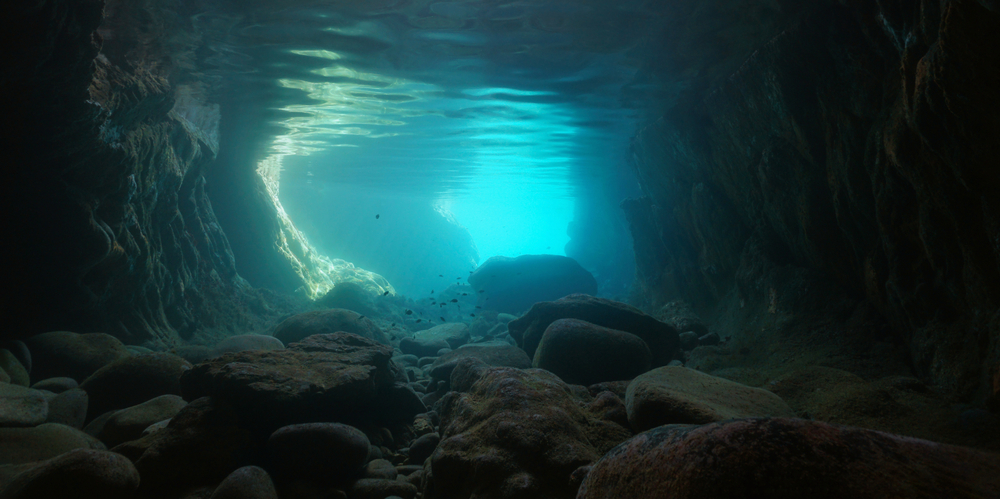
The Rise and Fall of Venus
Our neighboring planet Venus presents another gripping mystery: why did it transform into a fiery wasteland, while Earth flourished with life? Venus and Earth are often called “sister planets” due to their similar size, composition, and distance from the sun. However, where Earth developed conditions suitable for life, Venus turned into an inhospitable inferno with surface temperatures hot enough to melt lead and an atmosphere thick with carbon dioxide.
Theorists have long debated how such a close twin could follow such a divergent path. Some believe that Venus once had oceans and a temperate climate, but that a catastrophic greenhouse effect, potentially triggered by volcanic eruptions, led to its demise. Others suggest that solar winds may have stripped away any early water, preventing the development of an Earth-like environment. These hypotheses fuel a growing interest in studying Venus further, with upcoming missions by NASA and other space agencies aimed at uncovering more of its secrets.
Scientists believe Venus may have once harbored oceans, but something triggered a dramatic climate shift, resulting in its current harsh conditions. Understanding Venus’s transformation could provide insights into the forces that stabilize climates on rocky planets and offer warnings about potential climate scenarios on Earth. As researchers gear up for future missions to Venus, they hope to uncover evidence of its watery past and learn whether Earth’s “sister” ever had conditions similar to ours. Exploring Venus may one day help us protect our planet from a similar fate.
The Unknown Future of Animal Evolution
While much of evolution’s past is mapped through fossils and genetics, predicting the future of evolution is a challenging task. Human activities such as urbanization, pollution, and climate change have dramatically altered the planet’s ecosystems, prompting scientists to wonder: how will animals adapt to these changes over the coming millennia?
Experts predict that future evolutionary adaptations may favor animals that can thrive in human-altered environments. For example, some urban species might evolve smaller body sizes, enabling them to maneuver in confined spaces, or develop nocturnal habits to avoid human disturbances. On a larger scale, marine life may adapt to warmer and more acidic oceans, while land animals may evolve to endure pollution and habitat loss. These speculative projections underscore the resilience of life, but they also serve as reminders of humanity’s profound impact on Earth’s biodiversity.
Biologists propose several possibilities for the future of animal evolution. Some predict that animals will develop traits allowing them to thrive in human-dominated landscapes, such as resilience to pollutants or a reliance on urban food sources. This evolutionary guessing game highlights the resilience of life on Earth, yet it also raises ethical and environmental concerns. How we choose to manage natural habitats and combat climate change today will shape the paths that evolution takes, impacting not only future species but also the balance of Earth’s ecosystems. The future of animal evolution is one of the most dynamic mysteries, pointing to both nature’s adaptability and humanity’s influence on the natural world.

Consciousness: The Mind’s Greatest Mystery
Perhaps the most profound mystery lies within our own minds: the nature of human consciousness. Despite extensive research, scientists and philosophers alike remain puzzled by the origins and mechanisms of consciousness. While we understand some brain functions, such as memory and perception, consciousness itself—the experience of being aware—is still beyond full comprehension.
Some scientists believe that understanding consciousness may require a paradigm shift in how we view the mind and brain. Emerging theories suggest that consciousness might not be confined to human beings but could be a fundamental property of the universe, as essential as gravity or electromagnetism. Meanwhile, advanced neuroimaging tools are enabling researchers to observe brain patterns associated with conscious thought, but these studies have yet to answer why or how subjective experiences arise from physical processes.
Research into consciousness often falls into two camps: physicalist theories that explain consciousness as a product of neural activity, and dualist theories that suggest it may involve non-material elements. Scientists use technologies like fMRI and EEG to map brain activity, revealing patterns associated with awareness. Yet, no theory has definitively answered how these patterns translate into the experience of consciousness. Understanding this enigma could revolutionize fields ranging from artificial intelligence to mental health, shedding light on the mind’s depths and the very essence of what it means to be human. Consciousness remains a frontier of both scientific and philosophical exploration, bridging the tangible with the intangible.
The Universe’s Fate: How Will It End?
The universe had a beginning, so it makes sense to wonder—how’s it all going to end? It’s one of those questions that feels almost impossible to wrap our heads around, but scientists are trying. They’ve come up with a few big theories, each as mind-bending as the last.
One idea is the “Big Freeze.” In this scenario, the universe just keeps expanding, with everything drifting farther and farther apart until, eventually, it all goes cold and dark—no more stars, no more heat, just emptiness. Another possibility is the “Big Crunch,” where, instead of expanding forever, the universe could start pulling back on itself, ending up as one super-dense, hot point again. And then there’s the “Big Rip,” which sounds like the wildest one: if the universe keeps expanding faster and faster, it could eventually tear galaxies, stars, and even atoms apart. Talk about an intense finale.
What makes this tricky is that so much of it depends on dark matter and dark energy, two forces we don’t fully understand. Dark matter holds things together, while dark energy is pushing the universe to expand. Figuring out what these mysterious forces actually are could give us some real clues about where the universe is headed. But until then, we’re left with some pretty epic guesses—and a whole lot of mystery.
Embracing the Unknown: The Quest for Answers

When you think about these big mysteries—dark matter, consciousness, and what might happen to the universe—it’s pretty mind-blowing. There’s so much we still don’t understand! But maybe that’s what makes it all so interesting. These aren’t just questions with easy answers; they’re like doors that open into even bigger questions.
Every time scientists make a discovery, it feels like they’re getting closer, but somehow, new questions pop up. And that’s kind of the beauty of it. Science isn’t always about finding all the answers right away. It’s about exploring, learning, and just being curious about everything we don’t know yet.
So, who knows where this will all lead? Maybe we’ll solve some of these mysteries, or maybe we’ll just keep finding more things to wonder about. Either way, the adventure of figuring it out is what makes it all worth it.
Sources:
- Deep-sea discovery shines light on life in the twilight zone. (2024, September 24). ScienceDaily. https://www.sciencedaily.com/releases/2024/09/240925123650.htm#:~:text=The%20ocean’s%20twilight%20zone%20is,growth%20of%20bacteria%20is%20restricted.
- Paulson, S., Chalmers, D., Kahneman, D., Santos, L., & Schiff, N. (2013). The thinking ape: the enigma of human consciousness. Annals of the New York Academy of Sciences, 1303(1), 4–24. https://doi.org/10.1111/nyas.12165
Health
Are We Really Addicted to Our Phones? The Psychology Behind Digital Dependence

In today’s digital world, smartphones have transformed from mere gadgets into essential lifelines. They keep us connected, informed, and entertained, serving as our gateway to almost everything—from instant communication and endless information to a virtual space that feels like home. But as these devices nestle deeper into our daily lives, a growing question arises: When does helpful convenience cross into unhealthy attachment?
Phone addiction is more than a buzzword; it’s a reality for millions who find themselves checking their screens constantly, craving notifications, and feeling anxious without their devices. Could the device that connects us to the world be isolating us from it at the same time? In this article, we’ll explore the surprising psychology behind our digital dependency, the signs it may be affecting us, and practical ways to regain balance.
What Is Phone Addiction and Why Does It Happen?
Phone addiction, often referred to as “nomophobia” (the fear of being without a mobile phone), is characterized by excessive and compulsive use of smartphones, leading to significant interference with daily life, relationships, and responsibilities. This behavioral addiction shares similarities with other compulsive behaviors, such as gambling, where individuals experience a loss of control over their actions despite negative consequences.
The underlying mechanism of phone addiction is closely linked to the brain’s reward system, particularly the neurotransmitter dopamine. Dopamine plays a crucial role in motivating behavior by providing pleasurable sensations when we engage in rewarding activities. Smartphone use, especially interactions on social media, triggers the release of dopamine, reinforcing the behavior and creating a cycle of craving and reward. As noted by psychiatrist Anna Lembke, “That’s the hallmark of an addictive drug. It just intrinsically draws people in.”
Research has shown that notifications and social interactions via smartphones activate the brain’s reward pathways, leading to repeated engagement. A study published in the journal Frontiers in Psychiatry highlights that problematic cell-phone use has been associated with personality variables such as extraversion, neuroticism, and impulsivity, as well as psychiatric comorbidities like anxiety and depression.
The design of smartphones and applications also contributes to their addictive potential. Features like infinite scrolling and variable rewards are intentionally implemented to keep users engaged. Tristan Harris, a former Google design ethicist, pointed out that “services like Facebook and YouTube leverage our attention and engagement to sell ads or otherwise attract funding. It’s happening not by accident, but by design.”
Recognizing the Signs of Problematic Phone Use

Recognizing the signs of problematic phone use is essential for understanding and addressing potential addiction. Individuals may experience a range of symptoms, including:
- Preoccupation with the phone: Constantly thinking about or using the device, even during important tasks.
- Anxiety without access: Feeling anxious or disoriented when the phone is not nearby.
- Excessive use: Spending an inordinate amount of time on the phone, often at the expense of other activities.
- Negative emotions upon restriction: Experiencing irritability or distress when phone usage is limited.
These behaviors can lead to significant disruptions in daily life, affecting personal relationships, work, and overall well-being. A study published in BMC Psychiatry found that approximately 23% of children and young people exhibited problematic smartphone use, which was associated with increased odds of depression, anxiety, and poor sleep quality.
Additionally, the phenomenon of “ringxiety”—the false sensation of hearing a phone ring or feeling it vibrate when it hasn’t—has been identified as a symptom of phone addiction.
Impact of Phone Addiction on Daily Life

Excessive smartphone use, often termed “phone addiction,” can significantly disrupt various aspects of daily life. Research indicates that individuals with problematic smartphone use may experience increased social isolation, diminished self-confidence, and heightened levels of depression and anxiety.
A study published in Frontiers in Psychiatry found that problematic smartphone use is negatively associated with young adults’ psychosocial well-being, with time spent using smartphones influencing mental health.
The pervasive nature of smartphones can lead to constant distractions, adversely affecting productivity and concentration. This constant connectivity often results in sleep disturbances, as individuals may find it challenging to disconnect from their devices, leading to poor sleep quality and associated health issues.
Physical health is also at risk; prolonged smartphone use can cause eye strain, headaches, and musculoskeletal problems due to poor posture. Moreover, the overuse of smartphones can interfere with personal relationships, as face-to-face interactions may be neglected in favor of virtual communication, leading to weakened social bonds and increased feelings of loneliness.
In severe cases, phone addiction has been linked to more serious mental health concerns. A longitudinal study published in BMC Public Health found that mobile phone addiction during the COVID-19 quarantine period could directly predict suicidality in adolescents within the subsequent five months, even after controlling for depression and daytime sleepiness.
When to Seek Professional Help
Recognizing when to seek professional help for phone addiction is crucial, especially when self-regulation efforts prove insufficient. If excessive phone use significantly disrupts daily life, relationships, or mental health, consulting a mental health professional is advisable. Therapies such as Cognitive Behavioral Therapy (CBT) have shown effectiveness in addressing behavioral addictions, including phone addiction. CBT helps individuals identify and modify negative thought patterns and behaviors associated with excessive phone use.
Additionally, support groups like Internet and Tech Addiction Anonymous offer communal support and shared experiences, which can be beneficial in overcoming phone addiction.
Recognizing the need for professional assistance is a proactive step toward regaining control and fostering a healthier relationship with technology.
Reconnect with Life: Simple Steps to Break Free from Your Phone

Excessive smartphone use can disrupt daily life, affecting productivity, relationships, and mental well-being. To regain control over your phone usage, consider implementing the following strategies:
1. Set Clear Boundaries
Establish specific times and places where phone use is limited or prohibited. For instance, designate the dinner table or bedroom as phone-free zones to encourage face-to-face interactions and improve sleep quality.
2. Monitor and Limit Screen Time
Utilize built-in features or third-party apps to track your screen time. Setting daily limits for app usage can help you become more aware of your habits and reduce unnecessary phone use.
3. Turn Off Non-Essential Notifications
Disable notifications for apps that are not crucial. This reduces distractions and the compulsion to check your phone frequently. By minimizing interruptions, you can focus better on tasks at hand.
4. Engage in Offline Activities
Rediscover hobbies and activities that don’t involve screens, such as reading, exercising, or spending time outdoors. Engaging in offline pursuits can provide fulfillment and reduce the urge to reach for your phone out of boredom.
5. Implement the Pomodoro Technique
Adopt time management methods like the Pomodoro Technique, which involves working for a set period (e.g., 25 minutes) followed by a short break. This structure can help you stay focused and reduce the temptation to check your phone during work sessions.
6. Utilize Digital Well-being Tools
Many smartphones offer features that monitor and limit usage. For example, Apple’s Screen Time and Android’s Digital Wellbeing provide insights into your habits and allow you to set restrictions on app usage.
7. Seek Professional Support if Needed
If self-imposed measures aren’t effective, consider seeking help from a mental health professional. Therapies such as cognitive-behavioral therapy (CBT) have been shown to assist individuals in managing and overcoming behavioral addictions, including problematic phone use.
Reclaiming Control Over Technology
Breaking free from phone addiction is not merely about cutting down screen time; it’s about reclaiming control over your attention, time, and overall well-being. Recognizing the signs of problematic phone use and understanding its impact on your daily life are crucial steps toward change. By implementing practical strategies—like setting boundaries, engaging in offline activities, and seeking professional help when needed—you can foster a healthier relationship with your smartphone.
Remember, technology is a tool designed to enhance our lives, not control them. By taking conscious steps to manage your phone usage, you’re investing in better mental health, stronger relationships, and a more mindful existence. It’s about finding balance in a digitally connected world and ensuring that you’re present for the moments that truly matter.
News
How Automation Could Change the Workforce Forever: What We’re Not Prepared For

In recent years, artificial intelligence has surged beyond its experimental origins, embedding itself in daily operations across industries and changing the way we work in ways we could hardly have imagined a decade ago. Once the stuff of science fiction, AI is now a force powerful enough to redefine tasks, create new opportunities, and even spark concerns about the stability of certain careers. Predictions of AI-driven automation impacting millions of jobs have created a mix of excitement and apprehension, leaving workers and business leaders wondering: What lies ahead in the evolving relationship between AI and the workplace?
From automating repetitive tasks to tackling challenges on a scale beyond human capacity, AI’s role in shaping our future is just beginning to unfold. While some industries have been quick to embrace AI’s potential, others are still finding their footing. But one thing is clear—those who understand how to harness AI’s power effectively may stand to gain the most. In this article, we’ll journey through AI’s transformative impact on the workplace, uncovering the opportunities, challenges, and the steps businesses can take to navigate an AI-driven future.
AI’s Transformative Impact on Industries

Artificial intelligence (AI) is revolutionizing industries worldwide, reshaping operations, and redefining roles across various sectors. A 2023 report by Goldman Sachs highlights that AI-driven automation could disrupt up to 300 million jobs globally, with office and administrative support, legal work, and architecture and engineering in the U.S. facing significant risks.
The finance industry leads in AI adoption, utilizing algorithms for real-time data analysis to detect fraud and market fluctuations, thereby transforming risk management.
Manufacturing and technology sectors also exhibit high AI usage among executives, at 80% and 64% respectively, indicating a pronounced impact in these fields. Conversely, construction and finance sectors show lower adoption rates, suggesting untapped potential.
Geographical disparities in AI adoption are evident; for instance, executives in New York City have a higher adoption rate (73%) compared to those in Los Angeles (60%), reflecting regional differences in AI utilization.
AI and Workforce Demographics

Artificial Intelligence (AI) is reshaping the workforce, with its adoption influenced by various demographic factors. A study by Hunter Marketing reveals that 61% of male executives utilize AI, compared to 29% of female executives, indicating a significant gender disparity. This gap may stem from differences in accessibility, awareness, or confidence in AI technologies. Addressing this imbalance is crucial for fostering a diverse and inclusive work environment.
Age also plays a pivotal role in AI adoption. Executives aged 25 to 44 exhibit the highest usage rates at 61%, reflecting a greater openness to innovation. In contrast, only 22% of executives aged 65 and above engage with AI tools, possibly due to unfamiliarity or resistance to altering established work routines.
Income levels further influence AI adoption. Executives earning between $100,000 and $199,000 show a 61% adoption rate, while those earning over $200,000 have a lower rate of 53%. This trend suggests that higher earners might delegate AI-related tasks to subordinates, leading to less direct engagement with the technology.
Geographical location also affects AI utilization. For instance, executives in New York City have a higher adoption rate (73%) compared to those in Los Angeles (60%), highlighting regional differences in embracing AI technologies.
Opportunities and Challenges of AI Implementation
Artificial Intelligence (AI) is revolutionizing industries worldwide, offering unprecedented opportunities alongside significant challenges. A March 2023 report from Goldman Sachs highlights that AI could disrupt up to 300 million jobs globally, particularly in sectors involving routine tasks like office administration, legal work, and engineering. Conversely, AI has the potential to boost global GDP by 7% over time, underscoring its dual role as both a disruptor and a catalyst for growth.
The Hunter Marketing report, “Executive AI: What senior leaders think about AI in the workplace,” reveals that 61% of male executives and 29% of female executives currently use AI, indicating a gender gap in adoption. Age also plays a role, with 61% of executives aged 25 to 44 utilizing AI, compared to only 22% of those aged 65 and above. Income levels influence adoption rates as well; 61% of executives earning between $100,000 and $199,000 use AI, while the rate drops to 53% for those earning over $200,000. Industry-wise, manufacturing (80%) and technology (64%) sectors lead in AI usage, whereas construction (52%) and finance (62%) lag behind. Geographically, executives in New York City (73%) have a higher adoption rate than those in Los Angeles (60%).
Senior business leaders face challenges such as competitors innovating faster (47% of C-level executives). Ethical considerations are paramount, with 68% of leaders not using AI citing ethical concerns. Accuracy is another issue, as 45% of non-AI users believe the technology needs to be more accurate. Ownership concerns are evident, with 72% of executives not using AI stating that responsibility lies with the IT department. Additionally, 62% of business leaders feel the benefits of AI could be more transparent, indicating a need for better education on AI’s potential applications and advantages.
Preparing for an AI-Driven Future: Strategies for Success

As artificial intelligence (AI) continues to reshape industries, organizations must proactively prepare for an AI-driven future. Implementing effective strategies can help businesses navigate this transformation and harness AI’s potential.
Upskill and Reskill Employees
With AI automating routine tasks, the demand for advanced technological skills is rising. Investing in employee training programs focused on AI, machine learning, and data analytics is essential. This approach ensures that the workforce remains adaptable and equipped to handle new roles and responsibilities. According to a McKinsey report, “Automation will accelerate the shift in required workforce skills we have seen over the past 15 years.”
Foster a Culture of Innovation
Encouraging a culture that embraces change and innovation is vital. Regular workshops, training sessions, and brainstorming meetings can help employees explore AI’s potential applications within the organization. This environment promotes creativity and openness to new ideas, facilitating smoother AI integration.
Develop a Clear AI Strategy
A well-defined AI strategy outlines the objectives, goals, and desired outcomes of AI implementation. Identifying areas where AI can have the most significant impact and addressing potential challenges are crucial steps. The McKinsey Global Institute emphasizes the importance of “ensuring robust economic and productivity growth” through strategic AI adoption.
Collaborate with External Partners
Partnering with AI solution providers, research institutions, and industry experts grants access to cutting-edge technology and knowledge. Such collaborations can accelerate AI adoption and provide valuable insights into best practices and emerging trends.
Focus on Ethical AI Implementation
Addressing ethical considerations is paramount. Ensuring transparency, fairness, and accountability in AI deployments builds trust among employees and customers. Establishing clear guidelines and ethical standards for AI use is crucial. The McKinsey report highlights the need to “actively guard against the risks and mitigate any dangers” associated with AI.
Promote Diversity and Inclusion
A diverse and inclusive workforce brings varied perspectives, enhancing AI development and implementation. Addressing gender gaps in AI adoption and ensuring equal access to AI tools and opportunities are essential steps toward fostering inclusivity.
Implement Policies to Support Workforce Transitions
Governments and businesses should collaborate to develop policies supporting workers affected by AI-driven changes. Offering financial assistance for retraining, providing access to education and training programs, and promoting job creation in high-growth sectors are vital measures. The McKinsey Global Institute suggests “rethinking transition support and safety nets for workers affected” by AI.
Thriving in an AI-Driven World
As artificial intelligence reshapes industries and redefines roles, it presents an era filled with both challenges and vast opportunities. Companies that approach AI thoughtfully—investing in employee training, ethical standards, and strategic objectives—are more likely to thrive in this evolving landscape. By embracing a culture of innovation, promoting diversity, and establishing ethical guidelines, organizations can ensure AI serves not only to enhance productivity but also to foster a future where technology and human creativity work hand in hand.
Navigating an AI-driven future requires adaptability, responsibility, and forward-thinking. Businesses that harness AI’s potential thoughtfully will be well-positioned to lead in a world where change is constant. As we look ahead, the integration of AI promises to reshape industries profoundly; the organizations that embrace it strategically will drive the future of work.
News
Inside the ‘New Cold War’: How Countries Are Competing for Space and Resources Beyond Earth

Right now, there’s a new space race underway, but it’s not about just getting to the Moon or planting flags. This time, it’s all about finding and using resources out there that could change the game both in space and back on Earth.
Countries like the U.S. and China are leading this charge, each working on big plans for tapping into things like lunar water ice and valuable minerals. And it’s not just governments involved. Private companies like SpaceX and Blue Origin, along with newer startups, are jumping in too, pushing technology to make space mining a reality.
In this article, we’ll look at who’s involved, what they’re planning, and why it matters. With so many players aiming to unlock the potential of space, this race is setting the stage for what could be a whole new era of exploration and opportunity.
The Promise of Space Resources: Why Lunar and Extraterrestrial Resources Matter

Why is there so much interest in mining space? The answer lies in resources that could transform both space missions and life back on Earth. Take the Moon, for example. It’s not just a dry, dusty rock; its poles contain water ice, a resource with incredible potential. In space, water isn’t just for drinking—it can be split into hydrogen and oxygen, meaning it could provide breathable air for astronauts and even fuel for rockets. This makes it much more than a convenience; it’s a game-changer for anyone aiming to explore deeper into the solar system.
Besides water, the Moon and other nearby bodies contain valuable minerals and elements that are tough to find on Earth. One standout is helium-3, a rare isotope that has big potential as a clean energy source. On Earth, helium-3 could be used for nuclear fusion, a process that promises almost unlimited energy with hardly any pollution. It’s an exciting idea, especially as the world looks for cleaner, more sustainable power options.
For governments and private companies, tapping into these resources isn’t just about exploration—it’s about having a shot at future economic power and energy security. Whoever can reach, mine, and use these resources first could lead the next era of technology and even shift global power dynamics. Imagine a future where space minerals fuel new industries, where lunar water supports missions to Mars, and where helium-3 powers entire cities back on Earth. That’s the kind of future these nations and companies have in mind, and it’s why so many are investing heavily in technology to make space mining a reality.
In short, space resources could open the door to long-term missions, a self-sustaining space economy, and solutions to some of Earth’s biggest challenges. It’s not just science fiction anymore—it’s the next big step.
Futuristic Projects: Governments and Private Companies Leading the Charge
Making space mining a reality isn’t easy. It takes cutting-edge tech, major investments, and some seriously ambitious projects. Governments and private companies are both throwing their hats in the ring, each working on plans that could bring space resources within reach.
NASA’s Artemis program is probably the best-known effort right now. Their big goal? To set up a long-term human presence on the Moon. Artemis includes plans to build something called the Lunar Gateway, which is basically a small space station that’ll orbit the Moon and serve as a jumping-off point for astronauts. With the Gateway in place, NASA and its partners can start to dig deeper into the Moon’s surface and figure out how to live and work there. What’s interesting is that this isn’t just a U.S. project—more than 40 countries have signed on through the Artemis Accords, committing to work together as they explore the Moon.
China has its own ambitious plan through the International Lunar Research Station (ILRS). While it’s not as widely advertised, China’s goals are just as big. Teaming up with Russia, they’re working on a state-led lunar base they hope to establish by the late 2020s. China’s approach is a bit different from NASA’s. While NASA partners with private companies, China’s government is running the show, keeping close control over their technology and resources. They’re very focused on making this a strategic win, both in terms of tech and economic advantage.
Private Companies: Pushing Space Tech to New Heights
Private companies are also jumping into the race to make space resources accessible. SpaceX, with its reusable rockets, has already cut down the cost of going to space, and they’re working on lunar landers to support NASA’s missions. Then there’s Blue Origin, Jeff Bezos’s space venture, which is developing its own lunar landers and exploring ways to create a sustainable human presence on the Moon.
On top of that, a wave of startups is getting in on the action. Some are building mining robots that could dig into the Moon’s surface on their own, while others are focused on habitats that could help people live there longer. A big trend is something called “in-situ resource utilization,” or ISRU. This basically means using what’s already on the Moon—like water ice or minerals—so future missions don’t have to bring everything from Earth. It’s all about figuring out how to live off the land in space.
Together, these government programs and private projects are laying the foundation for what could become a true space economy. Governments are building the infrastructure, while private companies are coming up with ways to make mining and resource use practical and affordable. With each new mission, the idea of using space resources to fuel future exploration—and maybe even sustain life beyond Earth—starts to feel a bit more real.
Different Strategies for Space Exploration and Resource Access
The U.S. and China are both serious about leading the way in space, but they’re going about it in pretty different ways. Each country has its own strategy and is picking allies that line up with its goals, creating two very different approaches to the future of space.
The U.S. Game Plan: Teamwork and Partnerships
The U.S. is big on working with others. Through NASA’s Artemis program, they’re teaming up with other countries and private companies to share resources and knowledge. The idea here is that, by joining forces, everyone can make faster progress. The Artemis Accords—signed by over 40 countries—lay out some basic rules for cooperation, like keeping things transparent, peaceful, and fair when it comes to using resources. It’s a way to make sure everyone is on the same page from the start, especially as interest in space mining grows.
NASA also relies a lot on private companies, like SpaceX and Blue Origin, to help bring new technology into the mix. These companies are leading the charge in innovation, and by working with them, NASA doesn’t have to take on all the risk or cost alone. This approach lets the U.S. stay flexible and pull from a wide network of players, from governments to private businesses, all working toward a shared vision for space.

China’s Strategy: A More Solo Approach
China, on the other hand, is keeping things closer to home. Their government runs the show, leading its space missions through the China National Space Administration (CNSA). China has teamed up with Russia to create a lunar research station, but it’s mostly a state-controlled project. This means China is sticking to its own plans, controlling the technology and resources without relying much on other countries or companies. By keeping their space projects in-house, they can focus on their own long-term goals without needing outside support.
China’s centralized approach has some perks—it allows for quicker decisions and makes it easier to stay focused on specific goals. But it also means they aren’t building as many international partnerships, which could become an issue if space exploration gets even more collaborative down the line.
Two Different Paths to the Future of Space
These two strategies reflect two different visions for space. The U.S. is betting on teamwork and open partnerships, while China is focusing on self-reliance and strategic control. Both approaches have their upsides and challenges, and the way they unfold could have a big impact on who gets access to valuable space resources in the years to come.
In the end, this mix of competition and cooperation is likely to shape the rules of space exploration as we know it, with countries and companies figuring out how to work (and sometimes compete) side by side in a brand-new frontier.
The High Stakes and Big Dreams of the New Space Race

We’re in the middle of something exciting—a space race that’s all about using what’s out there to build something new. This isn’t just about putting flags on distant planets anymore. It’s about tapping into resources like water ice, rare minerals, and helium-3 on the Moon—things that could totally change how we live and work, both here on Earth and out there in space.
Sure, there’s competition. But getting this right will take some teamwork too. With so many countries and companies involved, figuring out how to share, cooperate, and play fair is going to be key. If we can strike that balance, space could become a resource that works for everyone.
This race is really about what’s possible. It’s about turning big ideas into real solutions and seeing if space can become a part of our world in ways we’ve only dreamed about. The journey’s just beginning, and where it leads could be incredible.
Good News
5 Groundbreaking Projects Changing Urban Living Forever

As climate change becomes a growing reality, cities around the world are stepping up as both contributors to the problem and potential leaders in the solution. With over half of the world’s population living in urban areas, cities generate a large chunk of global emissions—but they also serve as hubs for some of the most exciting climate solutions we’ve seen so far.
From cutting-edge transit systems to clean energy initiatives, cities are proving that innovation and creativity can reshape how we live, work, and connect with the environment. This article shines a light on urban areas that are not just tackling climate change but are transforming themselves into models of sustainable living. These cities are pioneering new ways to create a cleaner, greener future, and their extraordinary projects could be the blueprint for other urban centers worldwide.
How Cities Are Leading the Way in Climate Solutions
Cities have always been at the heart of big changes, and today they’re at the center of one of the biggest challenges we face: climate change. Urban areas are responsible for a large share of greenhouse gas emissions, but they’re also where some of the smartest climate solutions are taking shape. Across the world, a handful of cities aren’t just making small adjustments—they’re coming up with bold, new ways to tackle climate issues right where people live, work, and play.
These changes go far beyond planting a few trees or setting up recycling bins. Some cities are investing in public transit to cut down car trips and pollution, while others are creating jobs in clean energy to support local economies. There are even cities redesigning neighborhoods to reduce the need for cars altogether, giving people better access to parks, shops, and schools close to home.
These projects are powerful because they don’t just address climate change—they make everyday life better for people who live in these cities. Cleaner air, cooler neighborhoods, easier commutes, and green spaces close by all make city living healthier and more enjoyable.
What’s really exciting is that these cities are setting an example that others can follow. They’re proving that it’s possible to balance growth, sustainability, and quality of life. Let’s dive into some of these game-changing projects and see what they’re doing to create a cleaner, greener future.
Standout Cities and Their Eco-Innovations
Around the world, certain cities are standing out for their creative approaches to tackling climate change. These cities are thinking outside the box, with projects that don’t just aim to reduce emissions—they’re changing how people live day to day, often in ways that make life easier and more enjoyable. Let’s take a look at a few cities that are taking big steps toward a greener future.
Boston: Making Public Transit a Top Choice

Boston is on a mission to get more people out of their cars and onto public transit. The city wants to cut single-occupancy car trips in half by 2030, and they’re starting with a pilot program that’s giving free transit and bike passes to 1,000 residents in neighborhoods that were hit hard by the pandemic. The idea is simple: make transit more accessible and affordable, so people choose it over driving.
Early results have been promising, with bus and subway use tripling among those who received the passes. Building on this success, Boston has even used pandemic relief funds to keep some bus routes fare-free. This isn’t just about cutting emissions; it’s about making commuting more affordable and convenient, especially for those who need it most.
Columbus: Clean Energy with a Focus on Jobs
Columbus, Ohio, has set ambitious goals for reducing emissions—45% by 2030—but they’re also focused on creating opportunities for the community along the way. Through the Clean Energy Columbus initiative, the city is working to generate renewable energy with a special focus on job creation. This approach is expected to create up to 4,000 new jobs in Ohio, especially for underrepresented groups like people of color, women, and low-income youth.
What’s unique about Columbus’s plan is how they’re tying climate action to economic growth. The city is proving that clean energy isn’t just good for the environment; it’s also a chance to build a more inclusive economy. As Columbus’s Chief Sustainability Officer put it, having a clear vision for both the environment and community support helps to keep everyone aligned and motivated.
Honolulu: Reducing Traffic and Emissions with Rapid Transit Upgrades

Honolulu, famous for its beautiful beaches—and its traffic jams—is turning to clean transit to make commuting smoother and greener. The city recently fast-tracked a new bus lane on King Street, its busiest street, cutting commute times and making public transit more appealing. This project happened much faster than usual thanks to collaboration across four city departments, reducing the timeline by about a year.
The King Street bus lane is already making a difference, cutting down on delays and helping more people choose public transit over driving. This model is now being used to speed up other transit projects in Honolulu, including future bike and pedestrian paths. It’s a small but powerful shift that shows how making transit faster and more reliable can reduce emissions and ease daily commutes.
St. Paul: Making Electric Vehicles Accessible to All
St. Paul, Minnesota, is thinking big about transportation, with an equity-focused electric car-sharing program called Evie Carshare. This program puts 170 electric vehicles and 70 charging stations across the city, giving residents, especially those from under-resourced areas, access to affordable, eco-friendly transportation.
The city’s goal with Evie Carshare is to make the benefits of electric vehicles available to everyone, not just those who can afford to buy one. St. Paul’s Chief Resilience Officer explained that the community wanted climate action to be inclusive and accessible, and this program is a step in that direction. It’s a reminder that when it comes to climate solutions, accessibility and equity matter just as much as technology.
Transformative Climate Resilience Projects
As climate change brings more intense weather, cities are facing new risks like extreme heat, floods, and storms. Some cities are taking these challenges head-on, putting plans in place to protect people and infrastructure from the effects of a changing climate. The goal isn’t just to react to problems after they happen, but to build resilience so that urban life can withstand what’s to come.
Austin: Fighting Urban Heat with Trees
In Austin, Texas, the summer heat can feel relentless, especially in neighborhoods packed with concrete and fewer trees. Austin’s solution? Invest in “urban greening”—adding more trees and green spaces to cool down the city naturally. Their Climate Equity Plan aims to increase the city’s tree canopy, with a focus on planting in historically underserved neighborhoods where extreme heat hits the hardest.
Studies have shown that more tree coverage can cool urban temperatures by up to 9°F, which is huge during heatwaves. For Austin, it’s about more than just cooling the city; it’s about creating a fairer, healthier environment for everyone, especially those who have been impacted by climate change the most.
Tokyo: Climate-Proofing Buildings for Extreme Weather

Tokyo, Japan, has to contend with earthquakes, typhoons, and flooding, all of which are becoming more frequent and severe. To prepare, Tokyo has adopted some of the most advanced building codes in the world. New buildings are now designed to withstand everything from powerful earthquakes to heavy storms, using special materials and construction techniques like seismic base isolation systems.
This proactive approach has made Tokyo a model for resilience. According to a report by the World Bank, these climate-proof buildings could reduce economic losses from natural disasters by up to 30% in urban areas. For Tokyo, it’s about safety, but it’s also about keeping the city functioning smoothly, no matter what the weather brings.
New York City: Protecting Public Transit from Future Floods
When Hurricane Sandy hit New York City in 2012, it flooded the subway system, shutting down transit for days. Since then, the city has invested heavily in making the subway more resilient. Flood barriers, raised entrances, and waterproofed equipment are just a few of the upgrades New York has made to protect this essential part of the city’s infrastructure.
Now, the subway is better prepared to handle extreme weather events, reducing potential damage by half compared to pre-Sandy conditions. For a city like New York, where millions rely on public transit daily, these improvements are critical. They show how a little foresight can go a long way in protecting city life from the worst effects of climate change.
Each of these projects is more than just a protective measure—they’re part of a larger shift toward building cities that can adapt to and thrive in an uncertain climate. When cities invest in resilience, they’re not just preparing for tomorrow’s challenges; they’re making life better today.
The “15-Minute City” – Living Close, Living Green
Imagine a city where everything you need—your job, groceries, parks, schools—is just a short walk or bike ride away. That’s the vision behind the “15-Minute City.” It’s a way of designing neighborhoods so people don’t have to drive to get things done. This idea isn’t just better for the environment; it also helps build closer, friendlier communities.
Here’s how two cities are making this vision a reality.
Melbourne: Building “20-Minute Neighborhoods”
Melbourne, Australia, is bringing this idea to life with its “20-Minute Neighborhood” plan. The goal? Make sure that essential services are close enough that people can walk, bike, or use public transit to reach them in 20 minutes or less.
Studies from the University of Melbourne show these neighborhoods do more than cut traffic—they actually make people feel more connected and less stressed. It’s pretty simple: less time in the car means more time with family and friends. Melbourne is proving that planning for the planet can also make life better and simpler for everyone.
Paris: Bringing Life Closer to Home
Paris has taken the “15-Minute City” idea to heart. Led by Mayor Anne Hidalgo, the city is changing its streets to make them more welcoming for walking and biking. They’ve added green spaces, cut back on car lanes, and made neighborhoods feel more open and inviting.
The changes are already paying off. More people are choosing to walk or bike instead of drive, and neighborhoods feel more lively. By making essentials easy to reach, Paris is showing that city life can be less hectic and more community-focused. It’s a powerful example of how smart design can make cities better places to live.
The “15-Minute City” isn’t just about lowering emissions. It’s about creating neighborhoods where people have everything close by and life feels more connected. As more cities try out this idea, urban living could become greener, simpler, and a lot more enjoyable.
Cities Making a Real Difference

Cities around the world are showing us that change is possible, and it’s already happening. They’re finding smart ways to clean up the air, reduce traffic, create green spaces, and make city life better overall. These changes aren’t just good for the environment—they’re helping people live healthier, happier lives.
Think of a city where everything is close by, the air feels cleaner, and there are more places to relax and enjoy the outdoors. That’s what these cities are building. They’re not just preparing for the future—they’re making life better today.
What’s even more exciting is that they’re setting an example for others. If more cities join in, we’ll see urban living shift into something greener, friendlier, and more connected. It’s a big job, but with cities like these leading the way, we’re heading toward a brighter, more sustainable future.
Environment
Horrifying Images And Video Emerge As Ian Makes Landfall As “Catastrophic” Category 4 Hurricane

(ZH) – Accuweather has declared Hurricane Ian made landfall around 1420 ET on North Captiva Island, a barrier island just west of Fort Myers, Florida. The storm came ashore with maximum sustained winds of 155 mph.

This is absolutely shocking…
* * *
Update (1247ET):
The National Weather Service reports powerful Hurricane Ian is nearing landfall on the southwest coast of Florida. NWS expects “catastrophic storm surge and wind damage” will occur across Charlotte County, just north of Fort Myers.

Recent readings showed Ian had sustained winds of 155 mph, only 2 mph shy of a Category 5 storm. As of 1144 ET, the storm’s “outer eyewall” was about 20 miles from land, according to meteorologist Jason Boyer.
NWS provided satellite footage of Ian encompassing nearly the whole state of Florida.

NWS shows a 12-18 feet storm surge forecasted for Charlotte County.
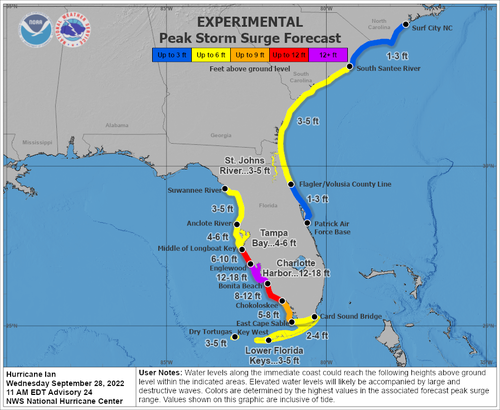
Horrifying videos have been posted on social media showing Ian’s wrath ahead of landfall expected this afternoon.
* * *
Update (0739ET):
Hurricane Ian continues to strengthen ahead of landfall. As of 0733 ET, the National Hurricane Center said Ian’s sustained maximum winds were 155 mph, just 2 mph shy of a Cat. 5 storm.

* * *
Hurricane Ian strengthened into a powerful Category 4 storm expected to make landfall on Florida’s southwest coast today and then traverse central Florida and emerge in the Atlantic by Thursday.
At 0500 ET, the National Hurricane Center said Ian sustained maximum winds of 140 mph and gusts up to 165 mph. The storm’s center was about 75 miles west-southwest of Naples and 105 miles south-southwest of Punta Gorda, moving north-northeast at 10 mph.
“Ian is forecast to approach the west coast of Florida as an extremely dangerous major hurricane, weakening is expected after landfall.
“On the forecast track, the center of Ian is expected to approach the west coast of Florida within the hurricane warning area this morning, and move onshore later today. The center of Ian is forecast to move over central Florida tonight and Thursday morning and emerge over the western Atlantic by late Thursday,” NHC senior hurricane specialist Daniel Brown told Orlando Sentinel.
Ian’s path has shifted south of Tampa Bay, and landfall is now expected between Fort Myers and Sarasota on Wednesday morning or early afternoon before moving across the central part of the state.
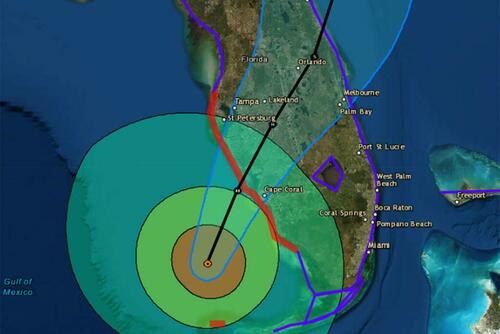
NHC warned a “life-threatening storm surge is expected along the Florida west coast and the Lower Florida Keys,” with “devastating wind damage” expected near Ian’s center.
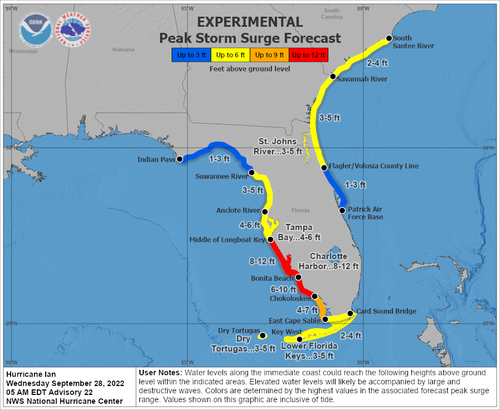
“Catastrophic flooding is expected across portions of central Florida with considerable flooding in southern Florida, northern Florida, southeastern Georgia and coastal South Carolina,” the weather agency continued.
“It’s going to be historic,” National Weather Service Melbourne meteorologist Kole Fehling in Melbourne, referring to the storm’s landfall impacts.
Fehling said Central Florida could be swamped with 15 to 20 inches of rainfall, with some areas receiving upwards of 24 inches.
“The normal value for the amount of rainfall over the entire year is about 52 inches,” he said. “So if we were to see those higher- end totals, we could be experiencing half of our total annual rainfall in a very short period of time.”
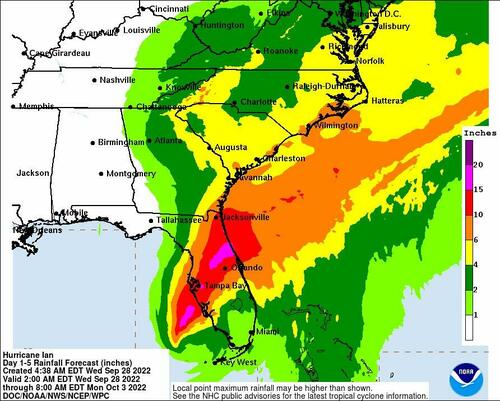
On Tuesday night, Florida Governor Ron DeSantis told residents:
“You need to evacuate now. You’re going to start feeling major impacts of this storm relatively soon.”
Millions of Floridians are under evacuation orders or advisories as DeSantis activated the National Guard earlier this week before the storm’s arrival.
There are notable economic impacts due to adverse weather conditions in the region. On Tuesday evening, US energy companies idled 190,000 barrels of daily crude production, some 11% of US Gulf of Mexico output.
Bloomberg pointed out that the “nation’s production of phosphate fertilizer” is in the storm’s path.
Chuck Watson, a disaster modeler with Enki Research, said Mosaic’s New Wales plant is “right in the middle of the damage swath,” adding the facility “could be out for weeks.”
Bloomberg said Ian could cause $45 billion in damage, which would make it one of the most costly storms in the country’s history.
By late Tuesday, over 2,000 flights to and from Florida were canceled. Flight delays and cancelations could spill over to the rest of the country.
Republished from Zero hedge with permission.
-

 Awareness2 days ago
Awareness2 days agoBleeding Eye’ Virus Sparks Travel Warning and Worldwide Concern – What Is the Incurable Disease?
-

 Entertainment2 days ago
Entertainment2 days agoJames Franco explained how life is now different after being ‘cast out’ of Hollywood
-
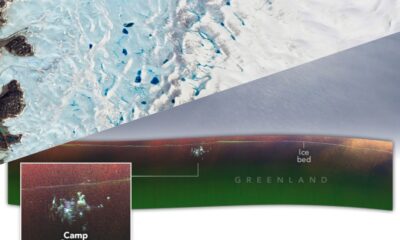
 Ancient History5 days ago
Ancient History5 days agoNASA Finds Underground ‘City’ Hidden 100 Foot Below Icy Surface
-

 News5 days ago
News5 days agoCalifornian Man Who Spends His Time Searching for Abandoned Cars on Google Maps Has Found Some Unbelievable Things in America






